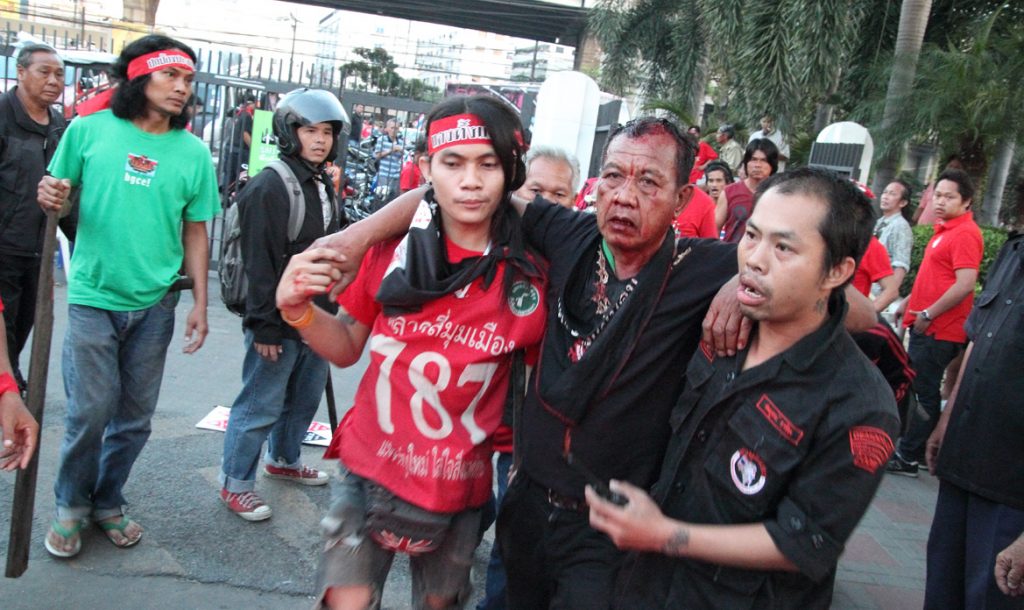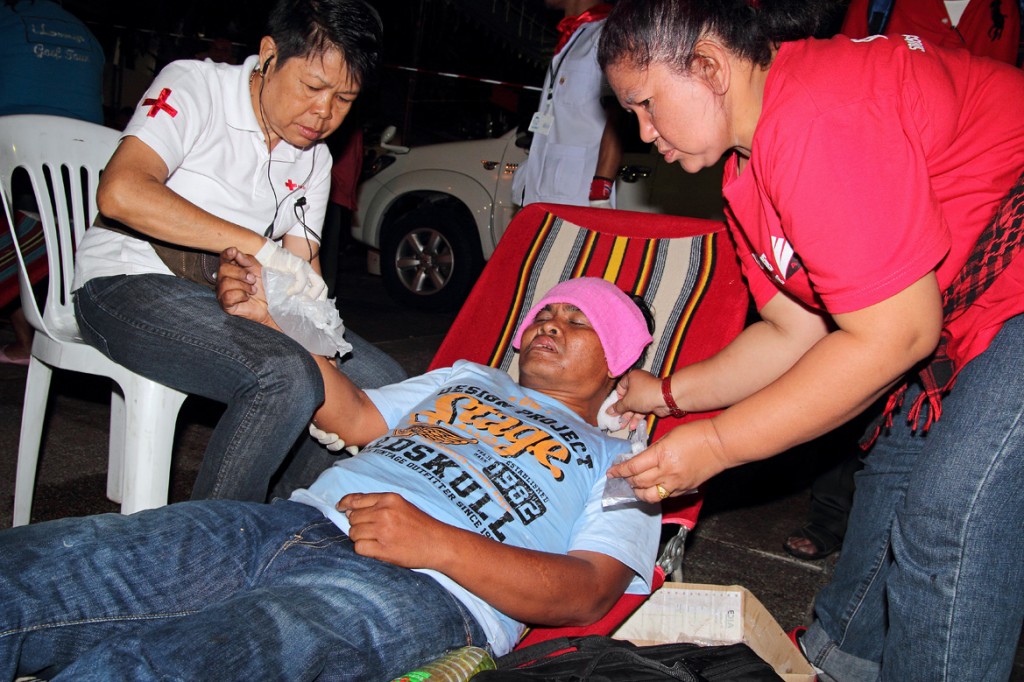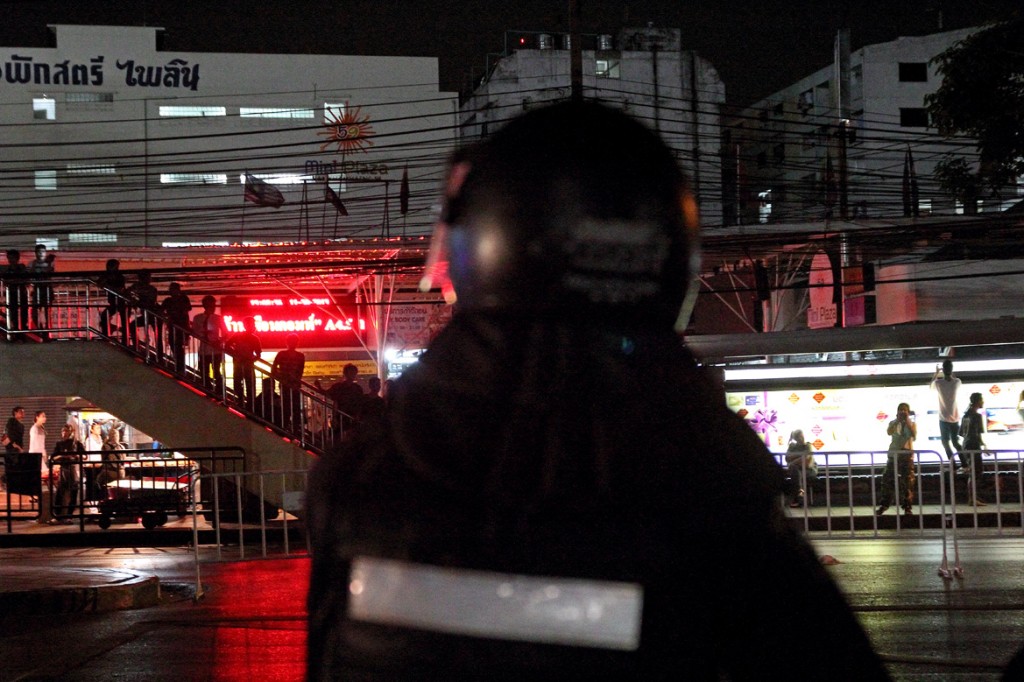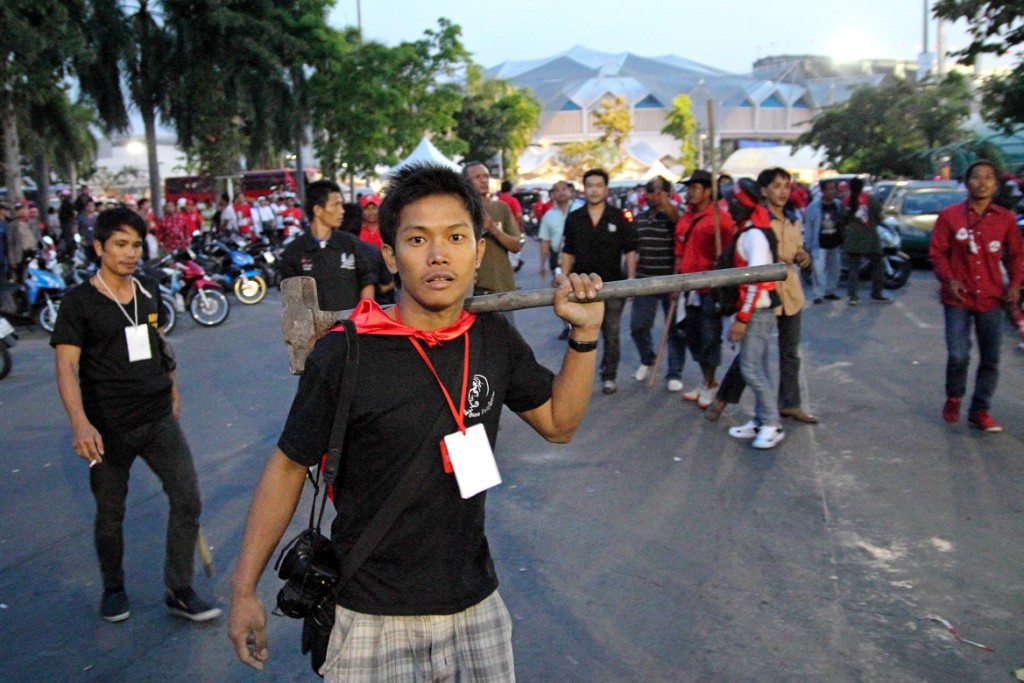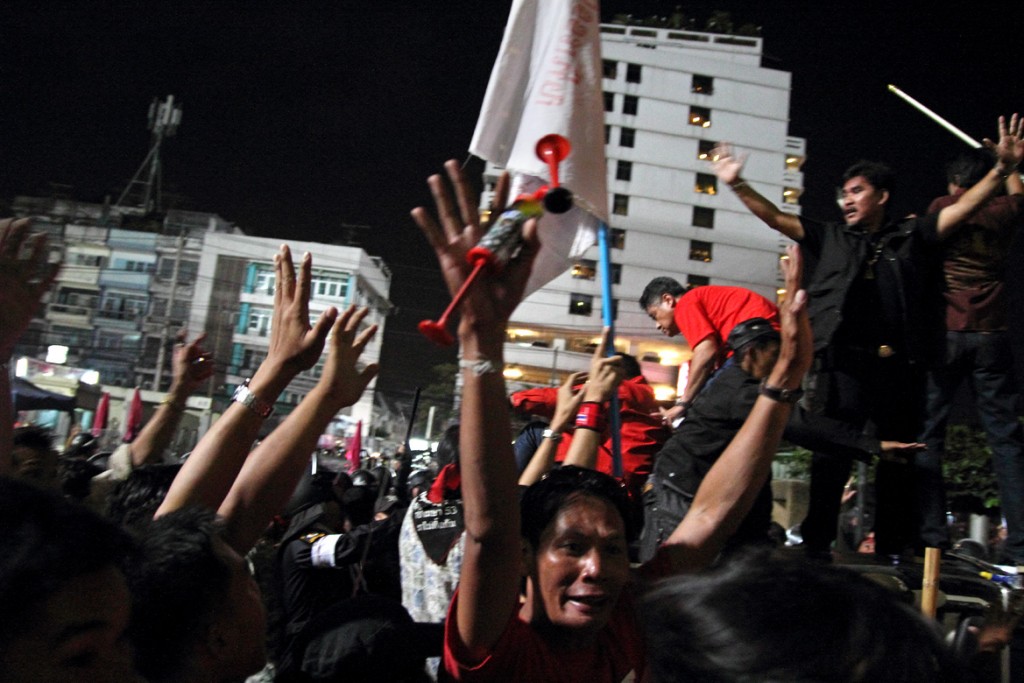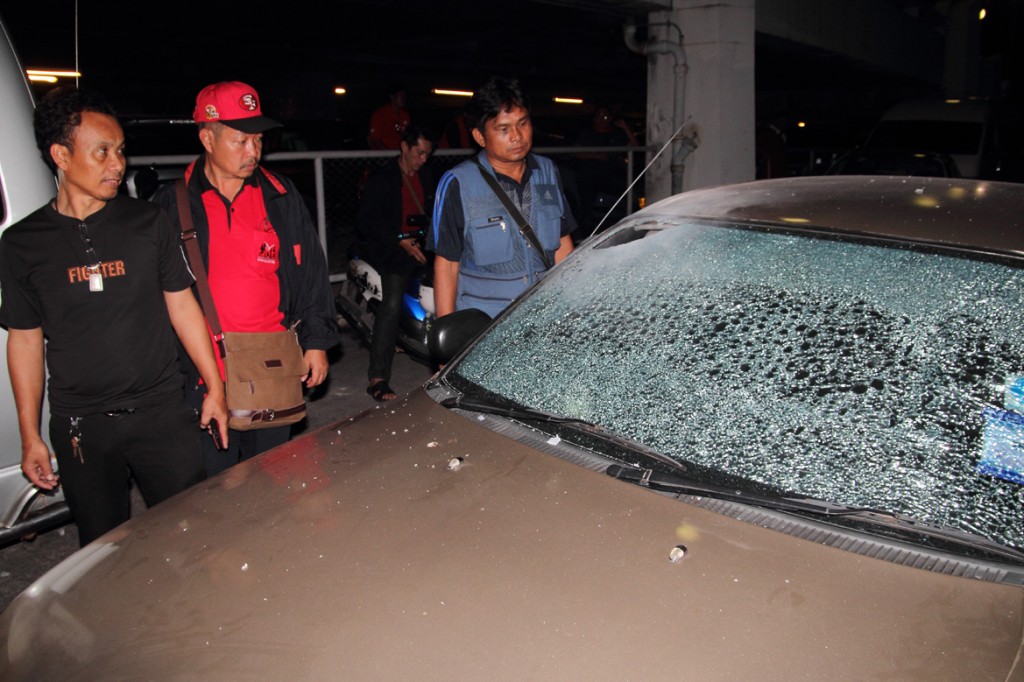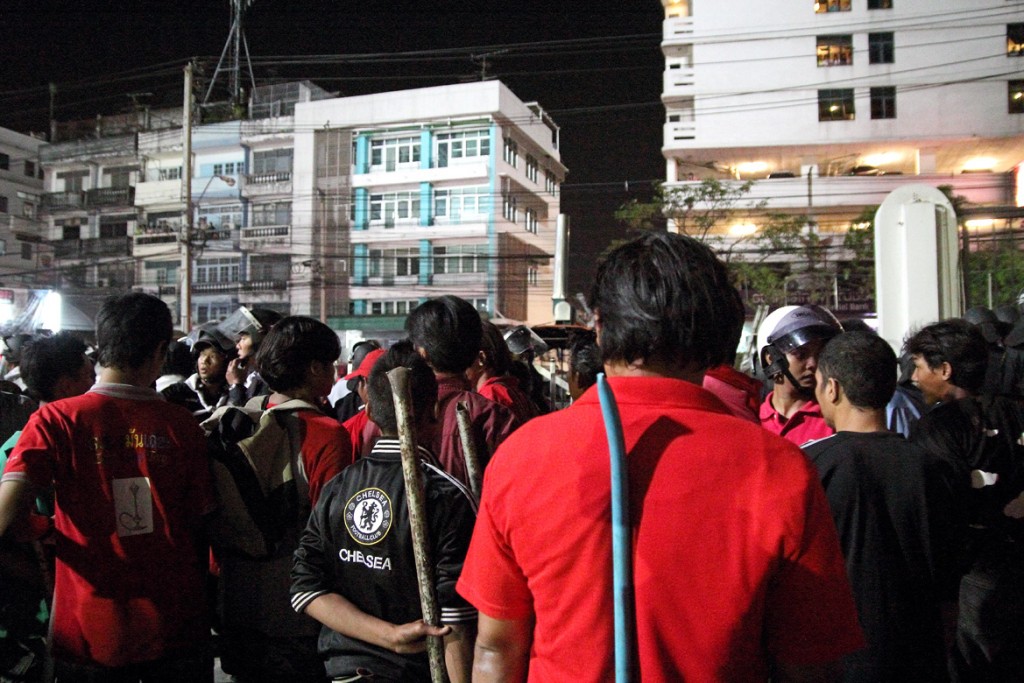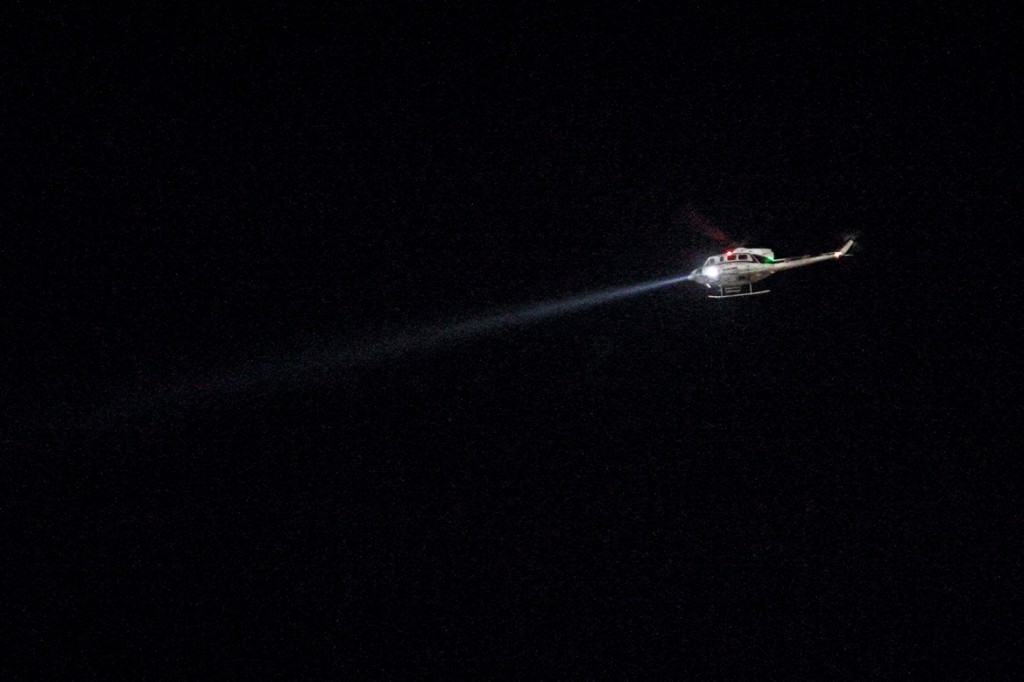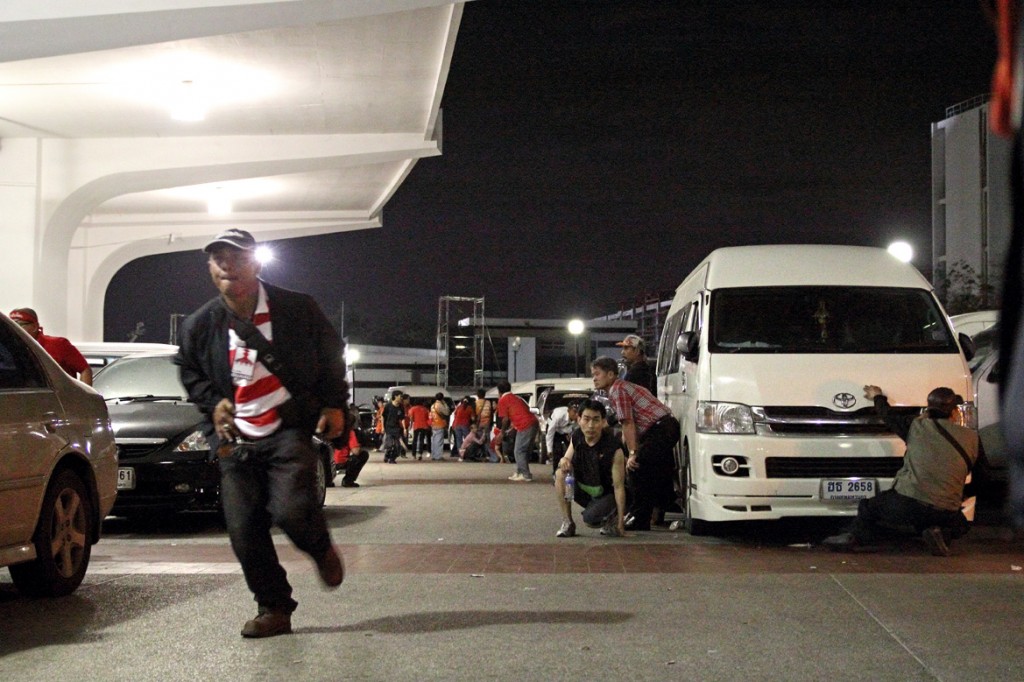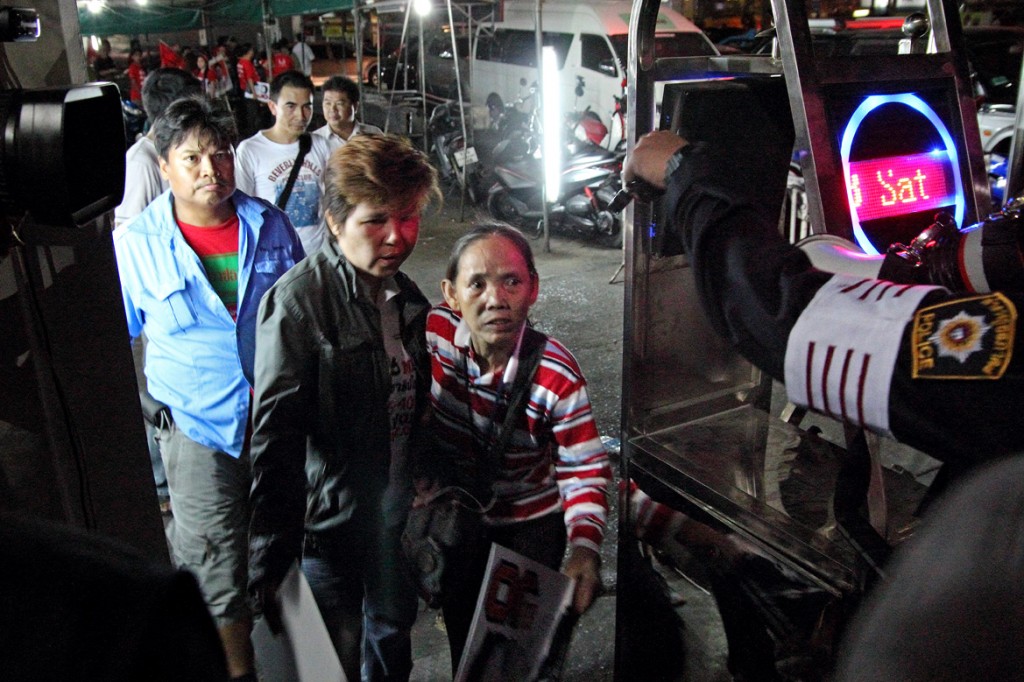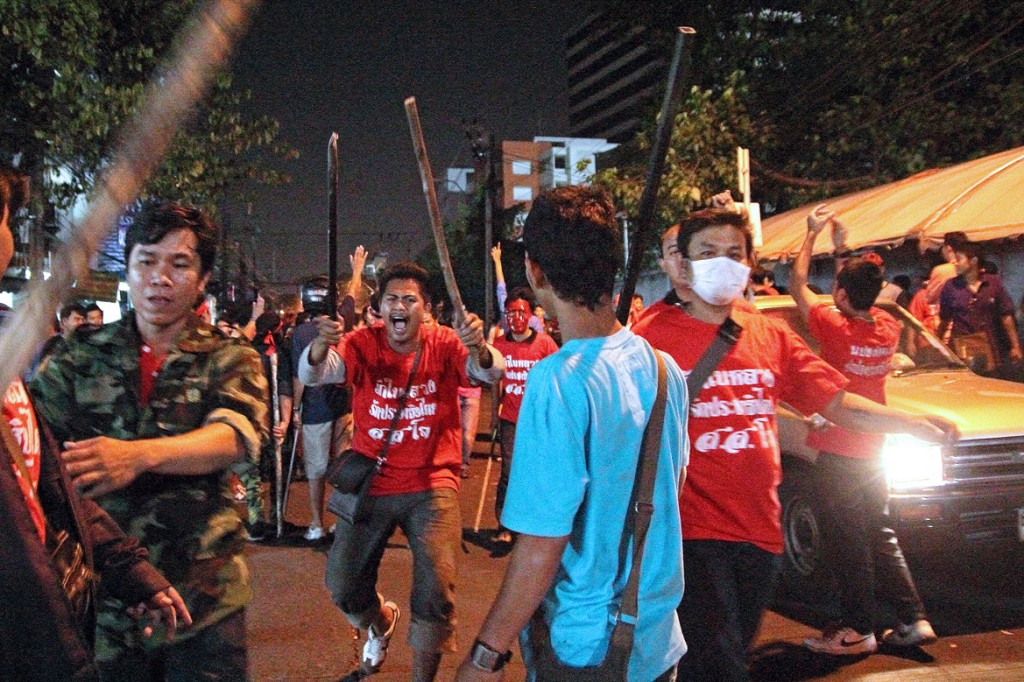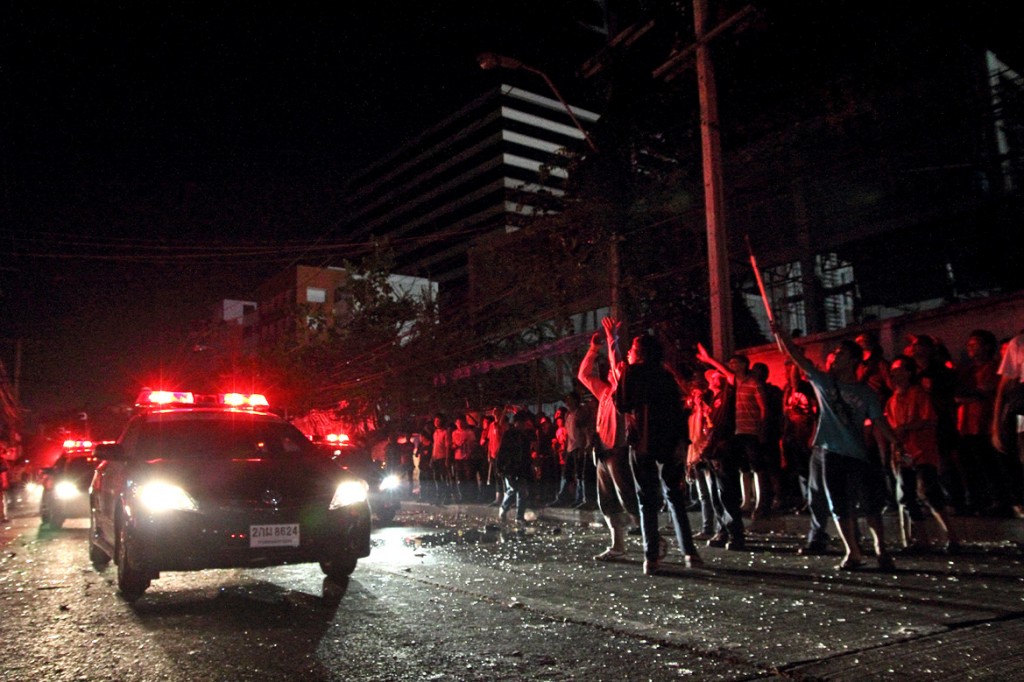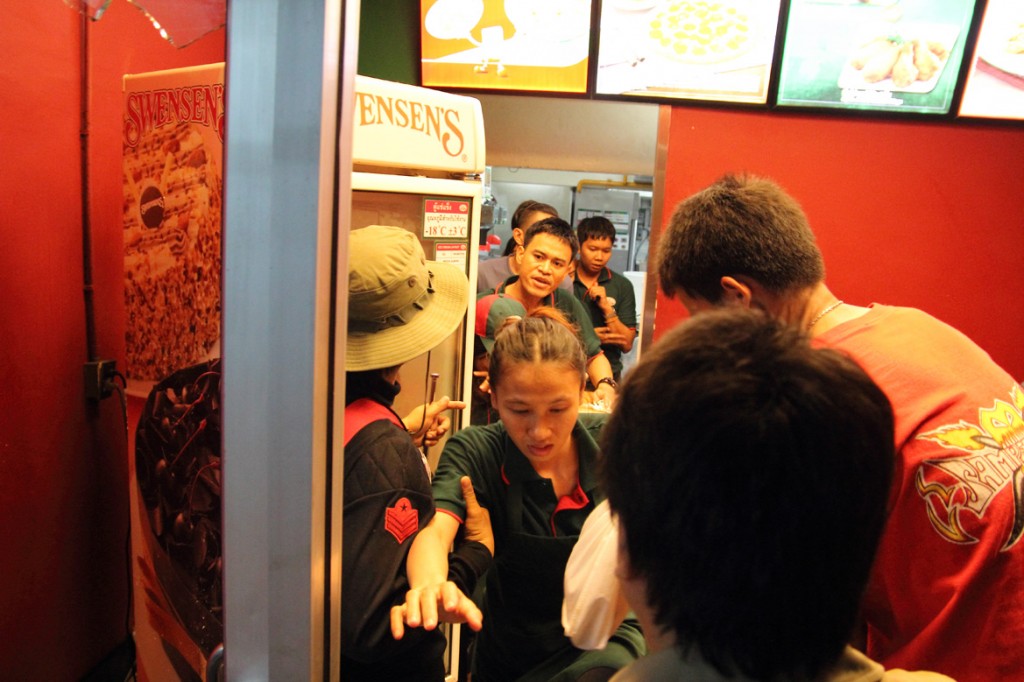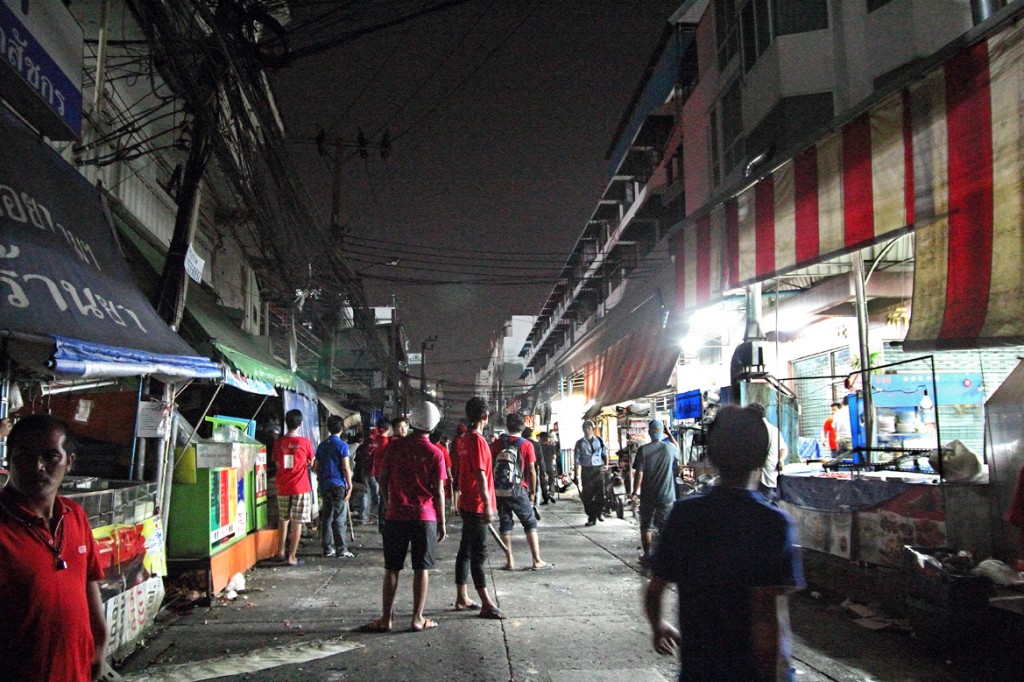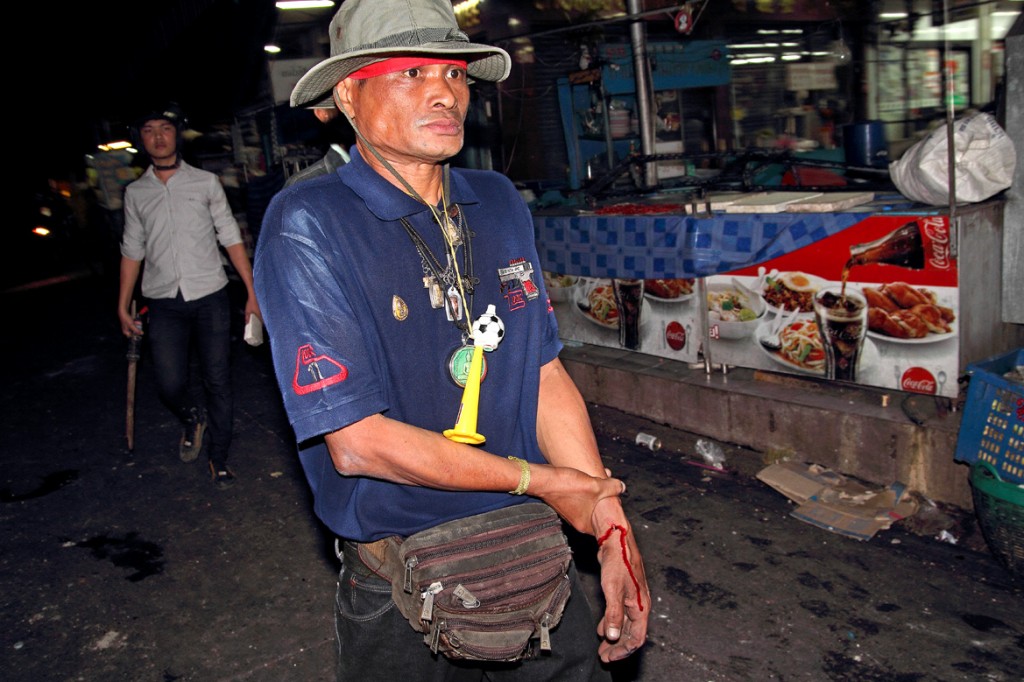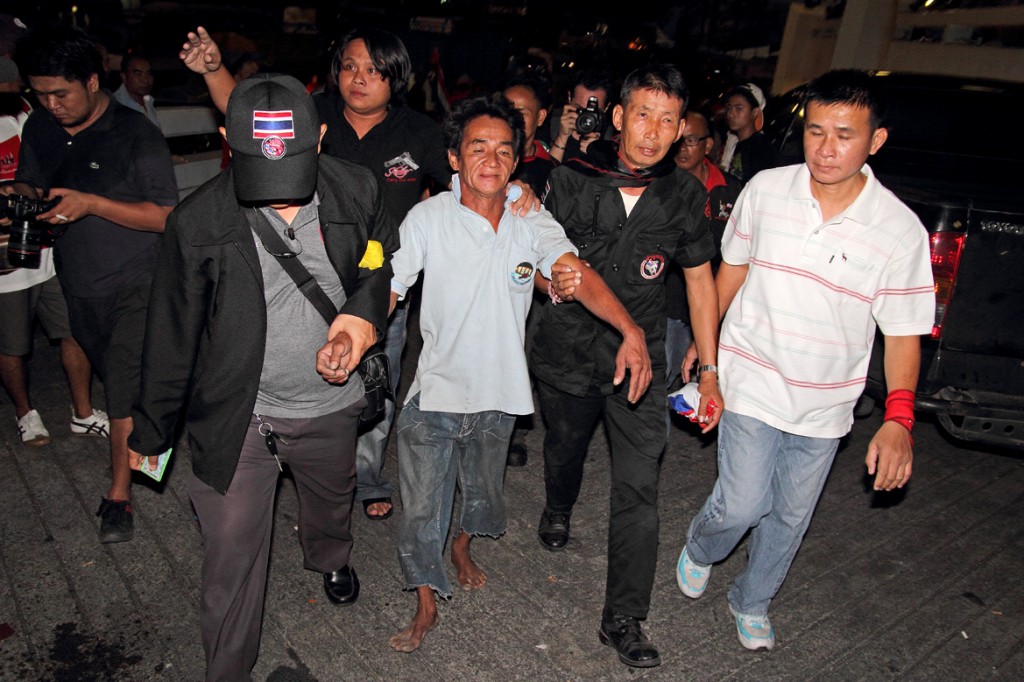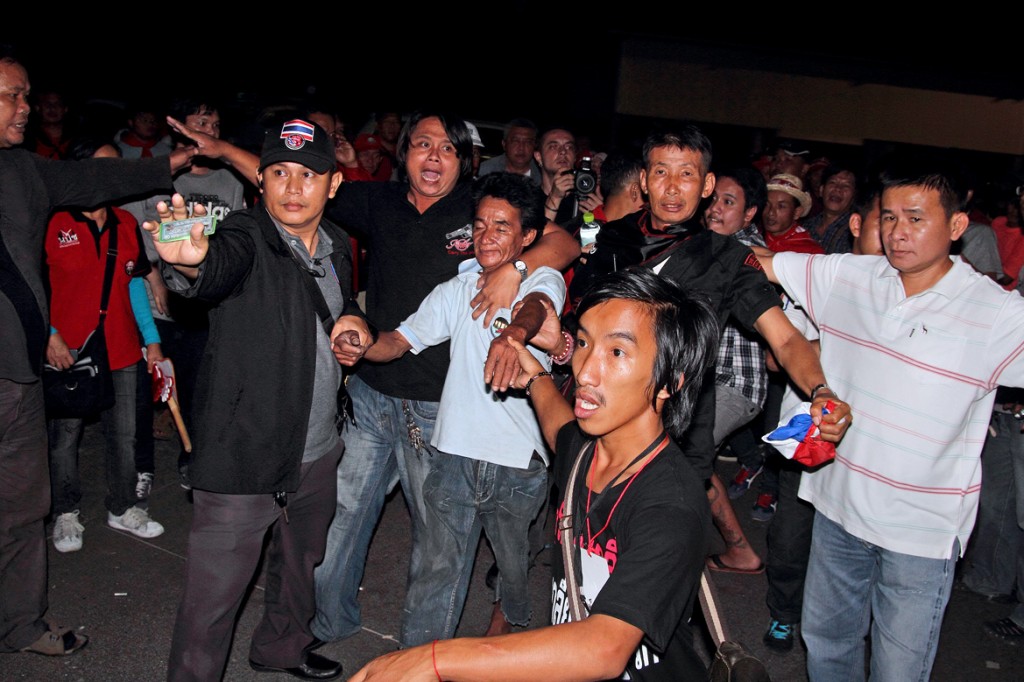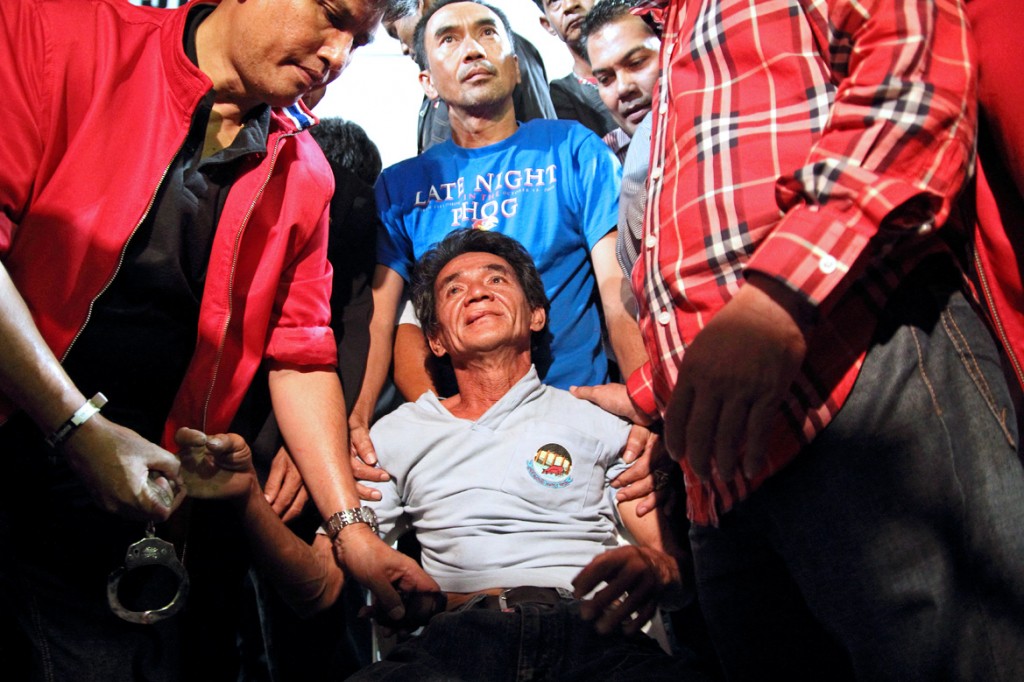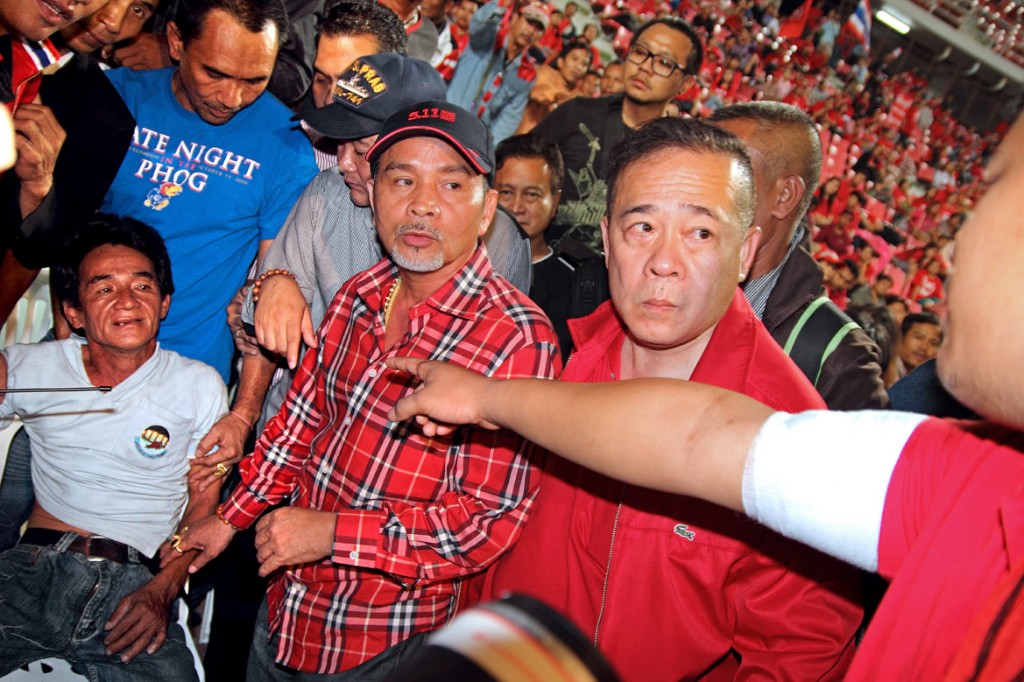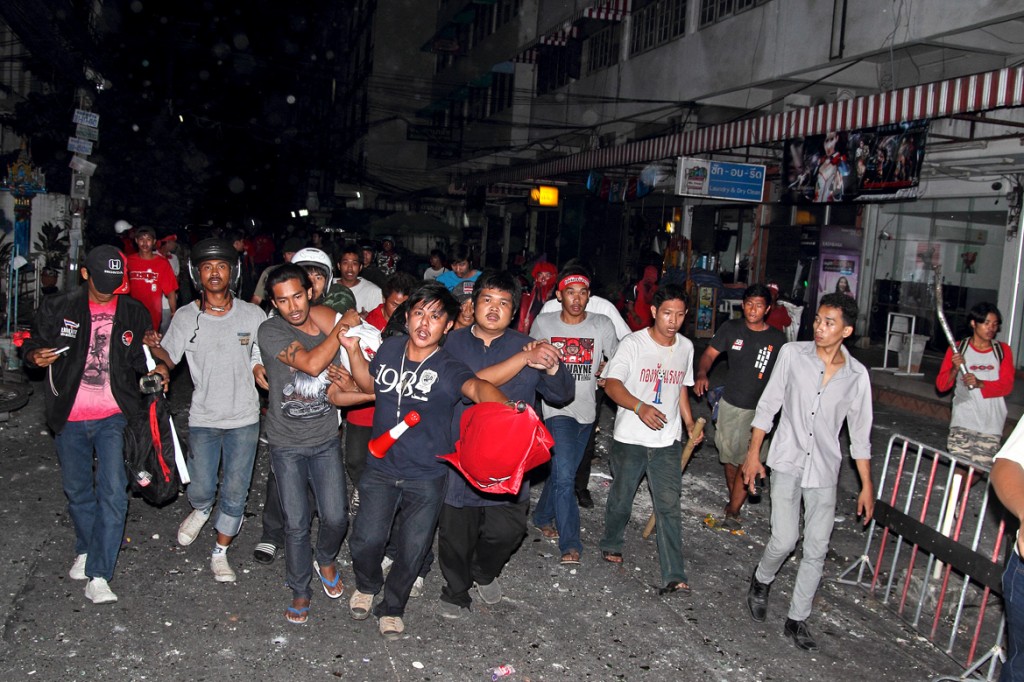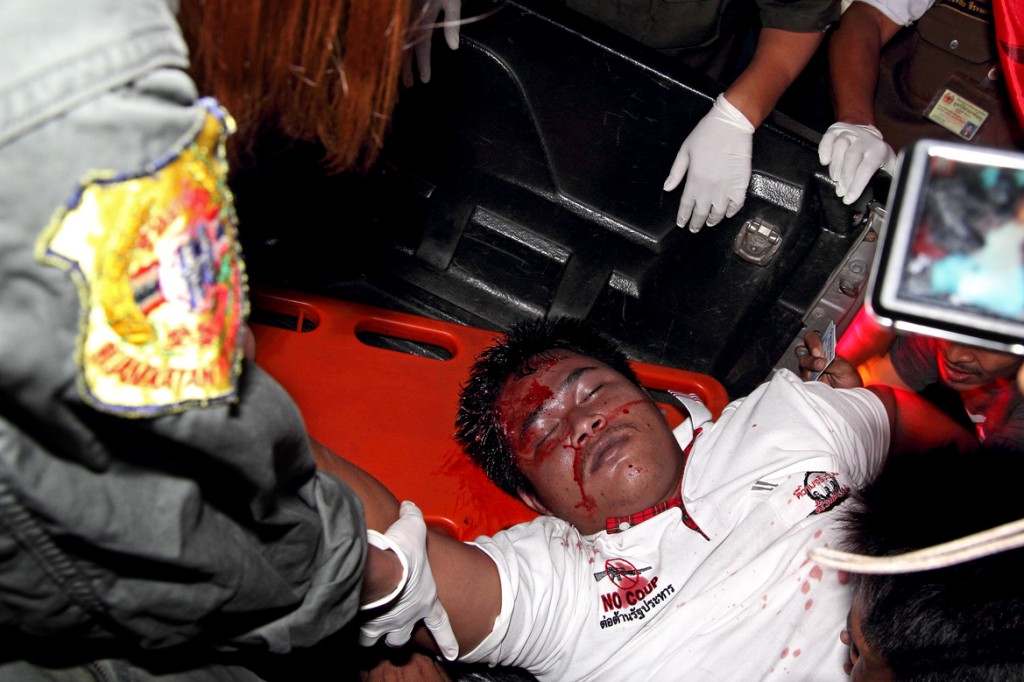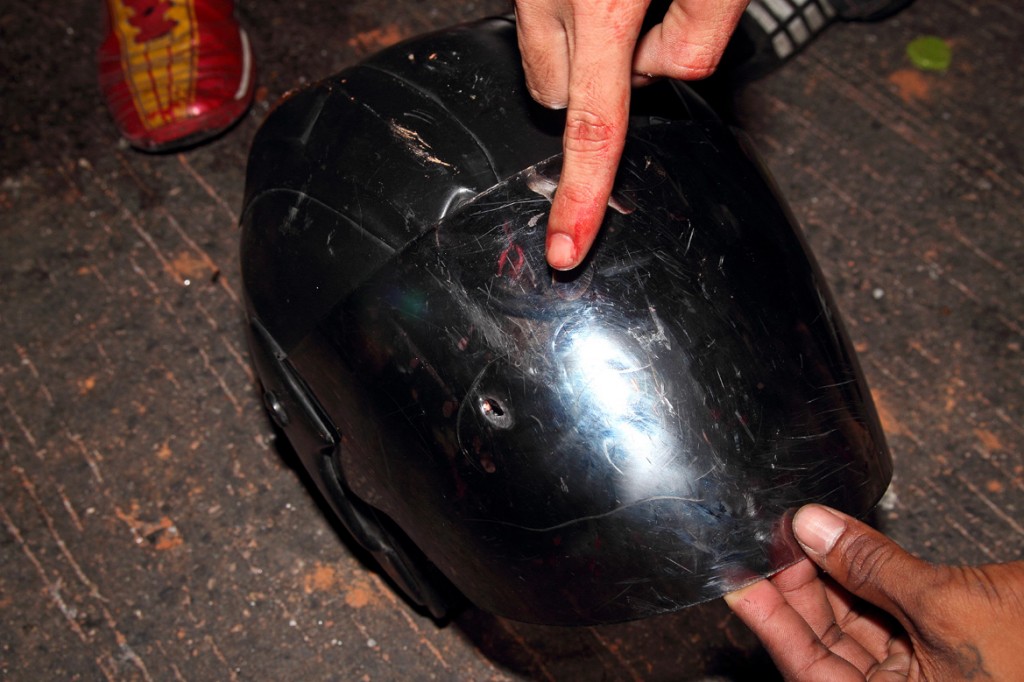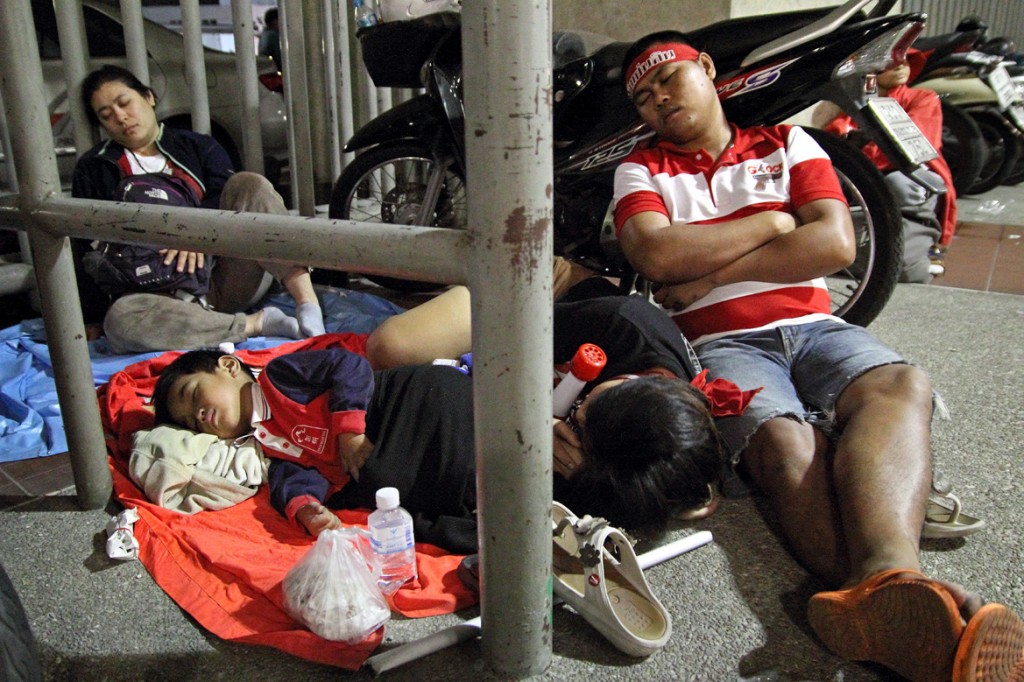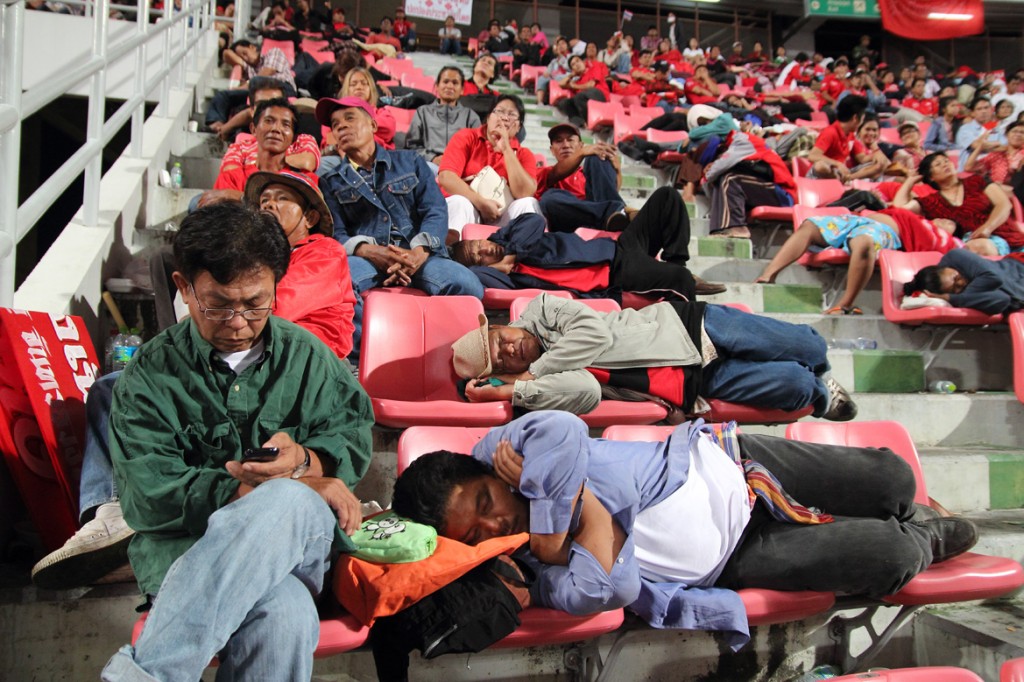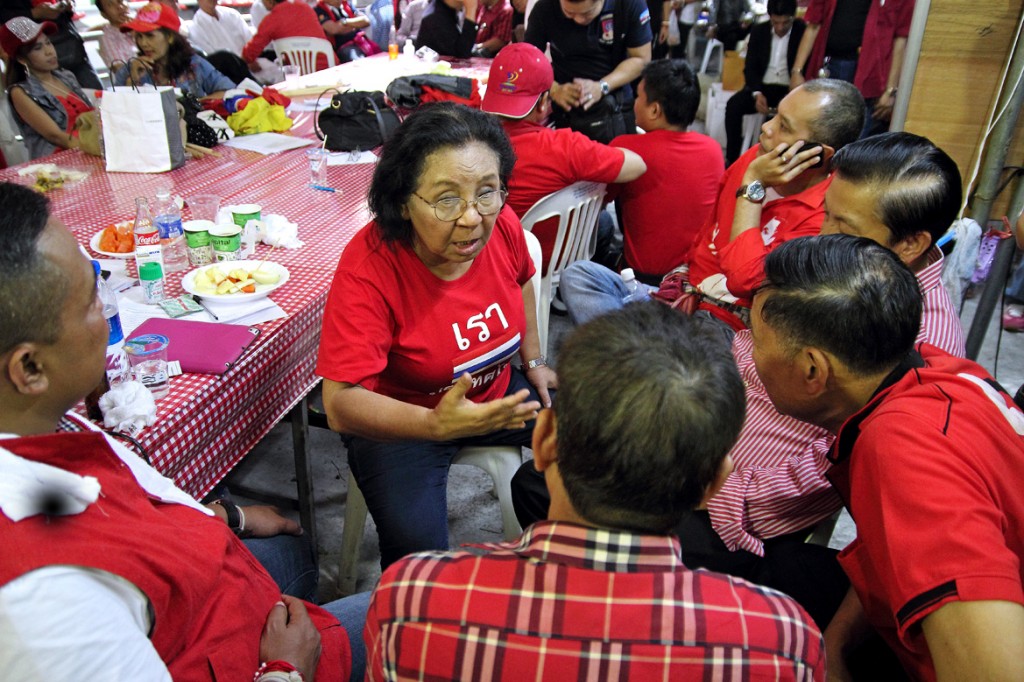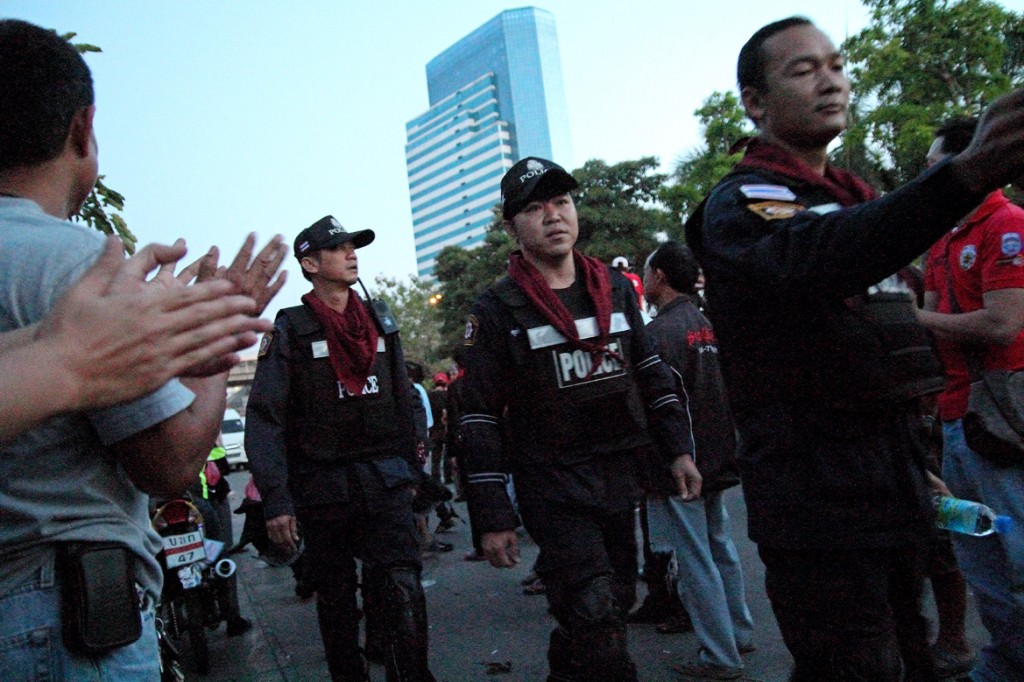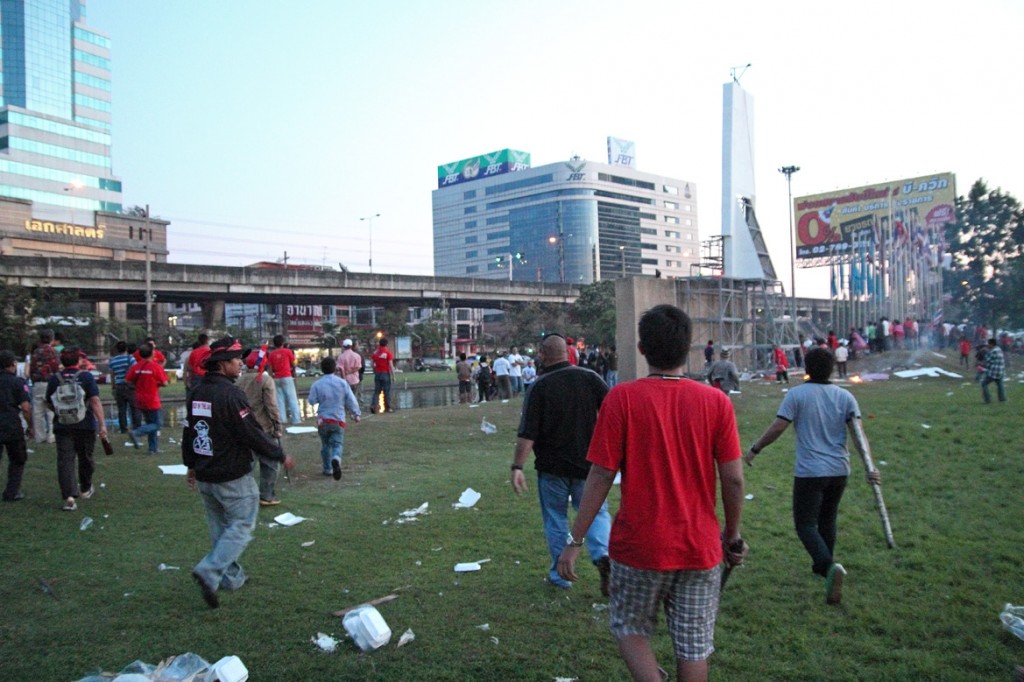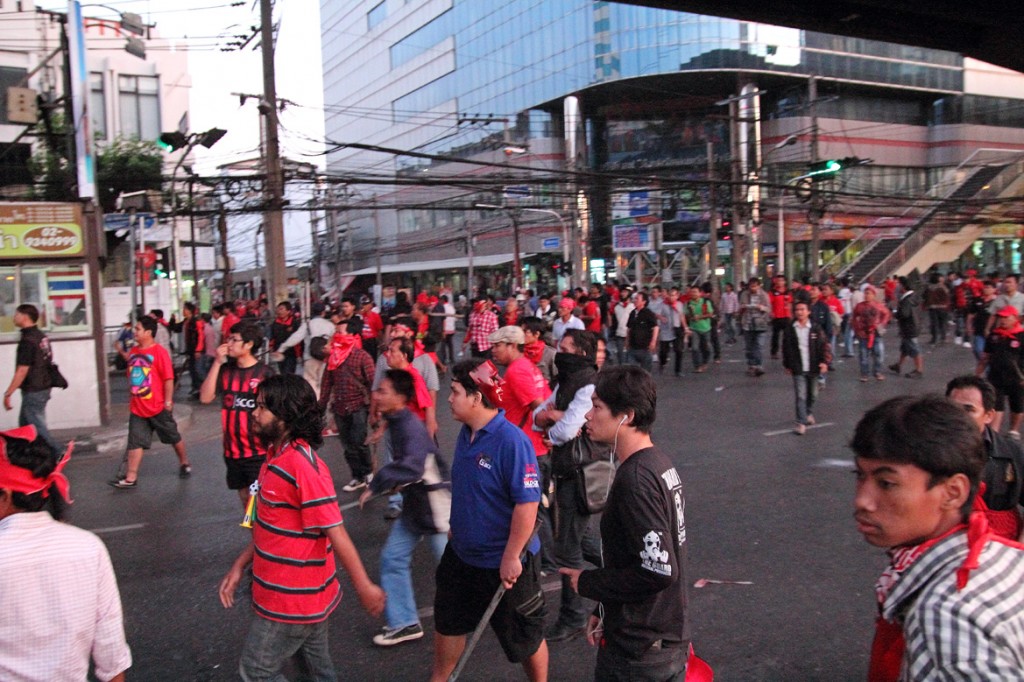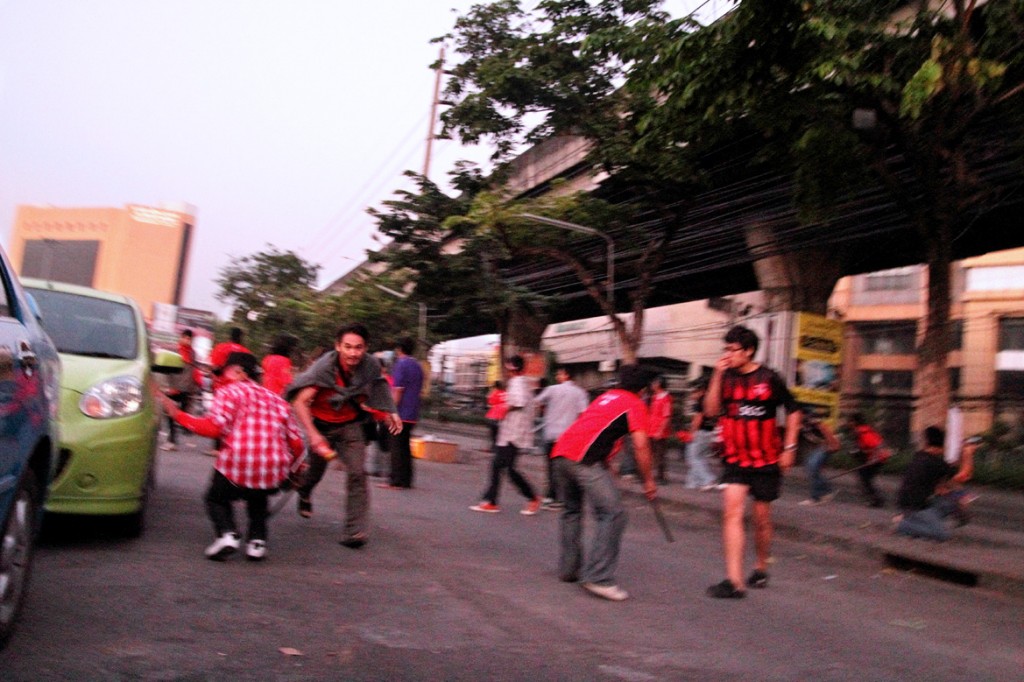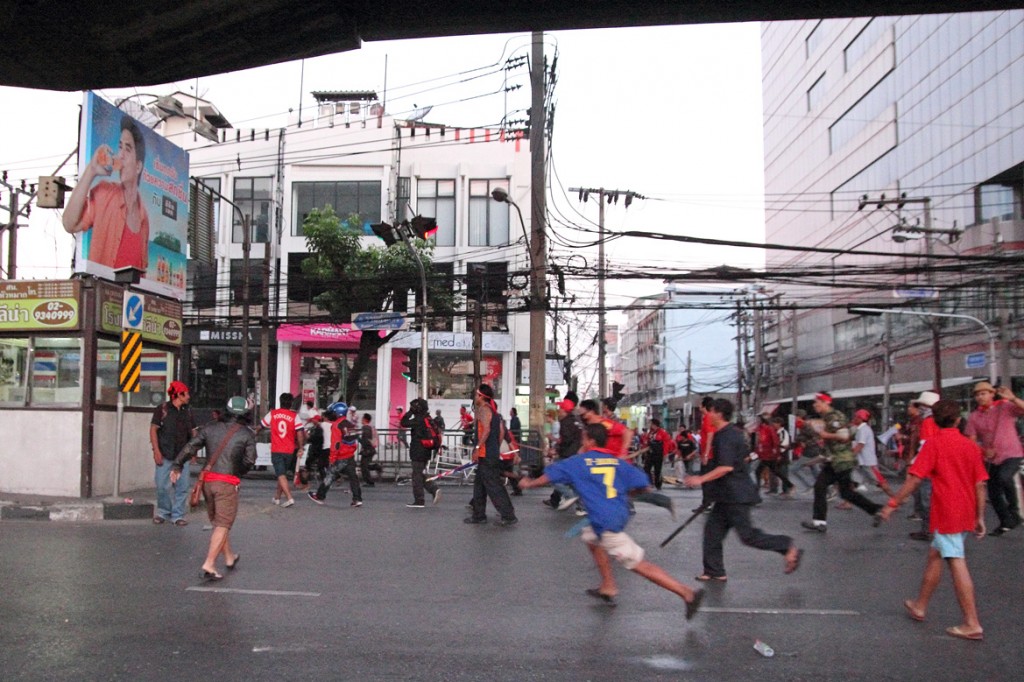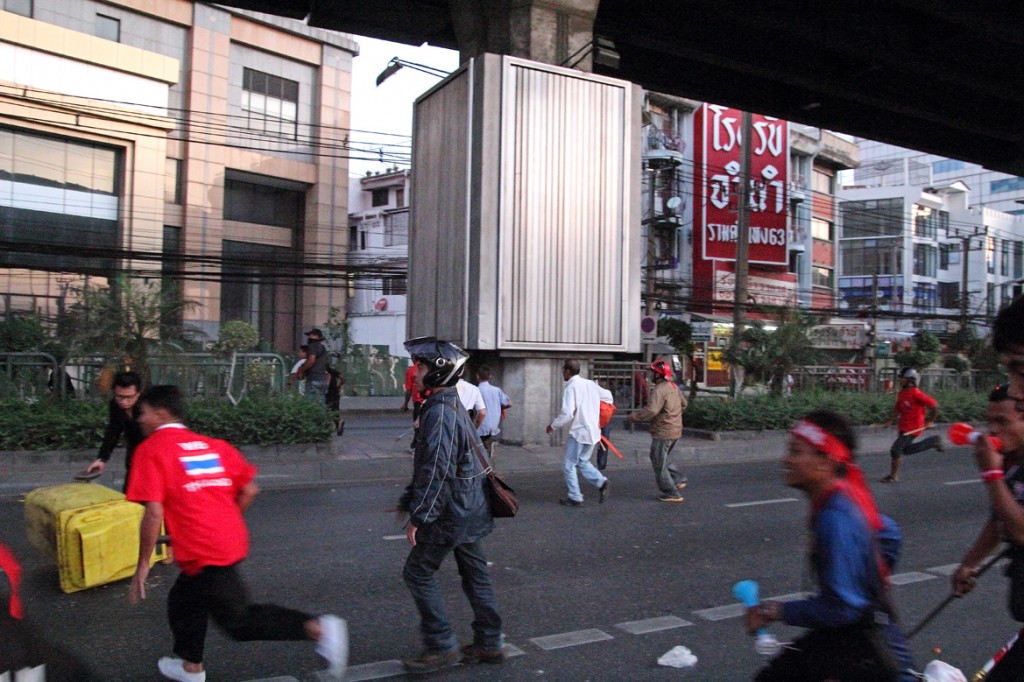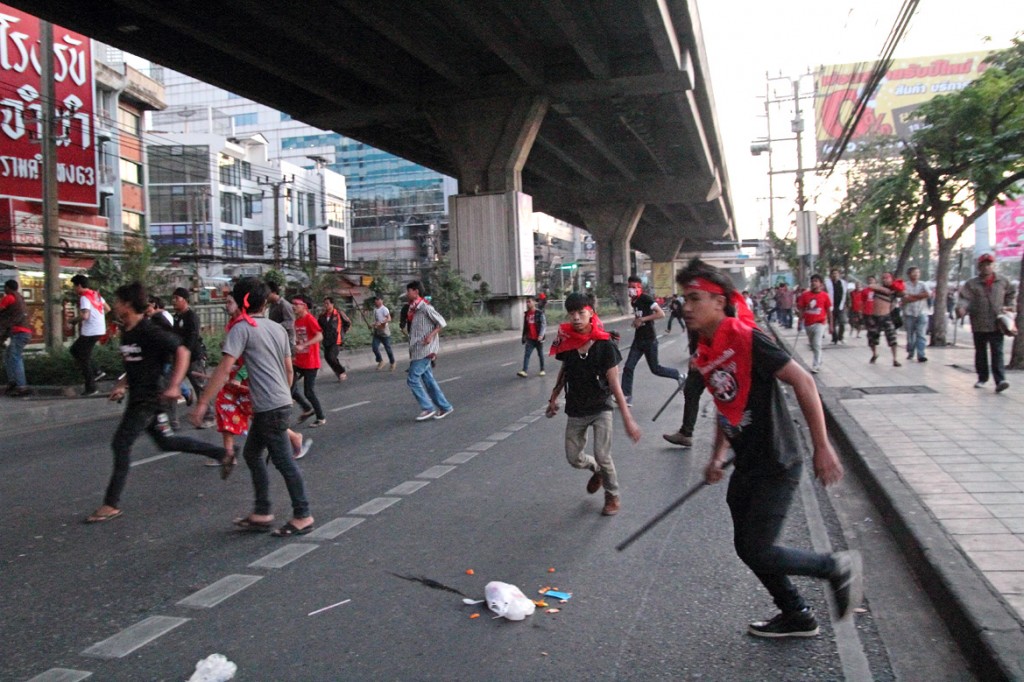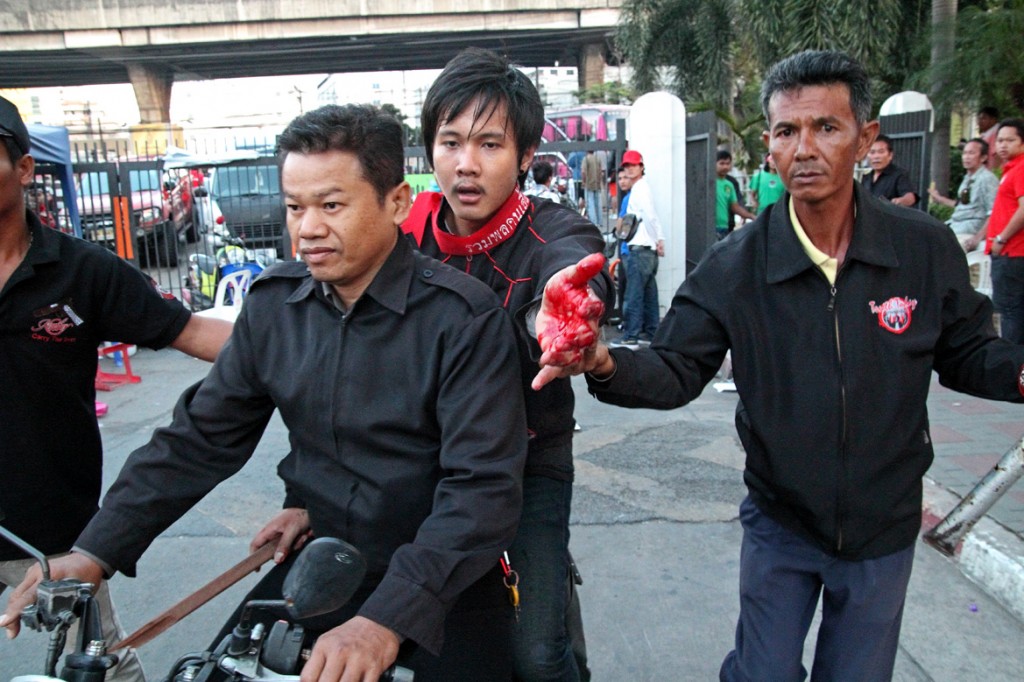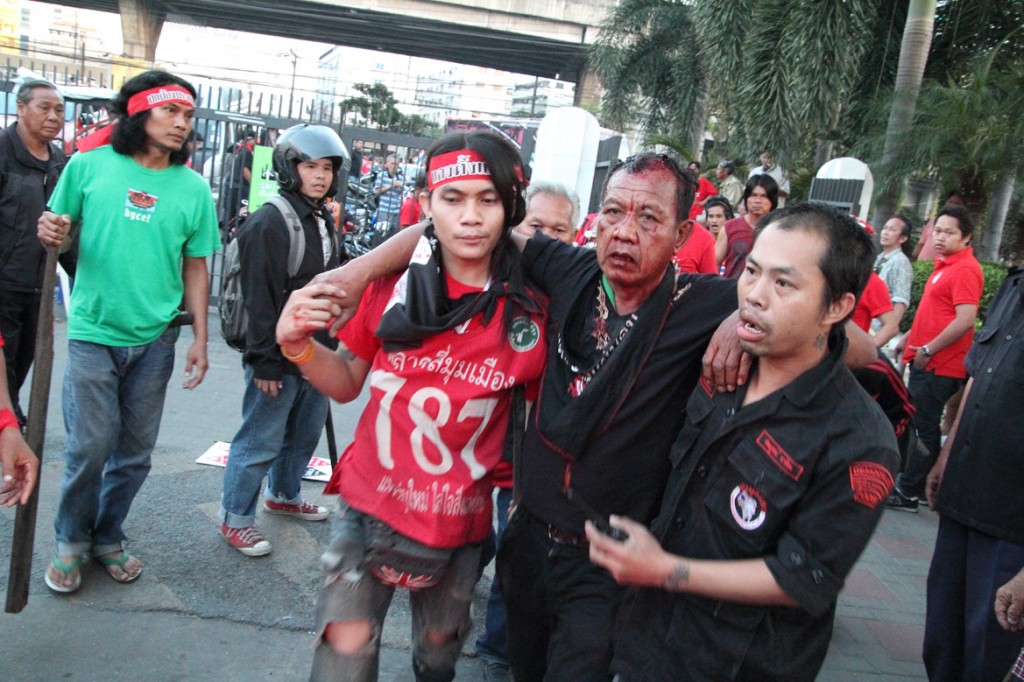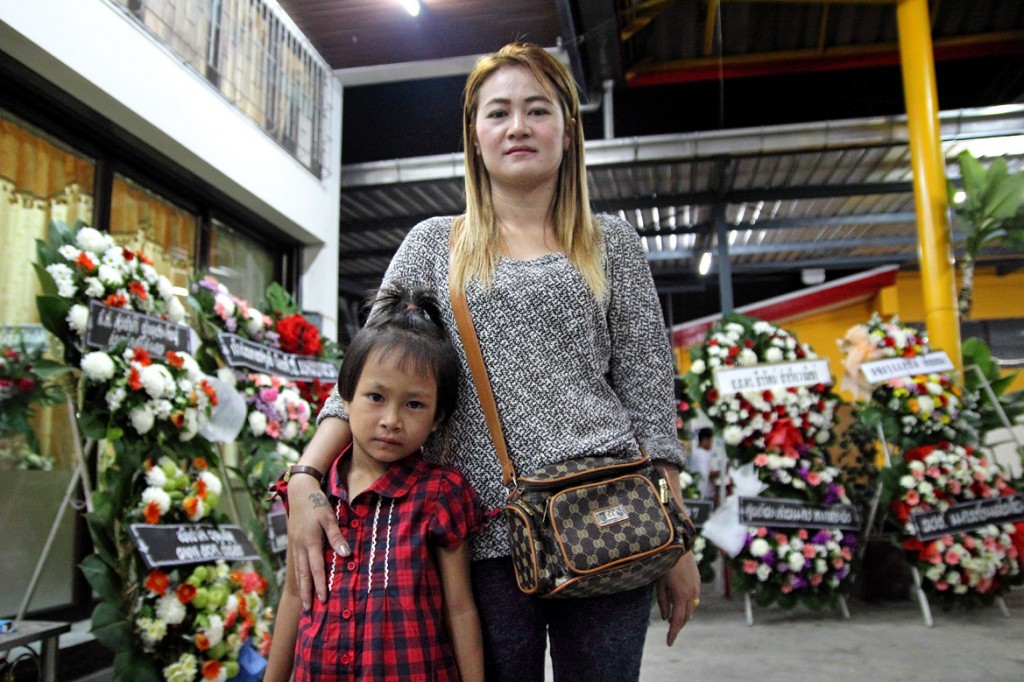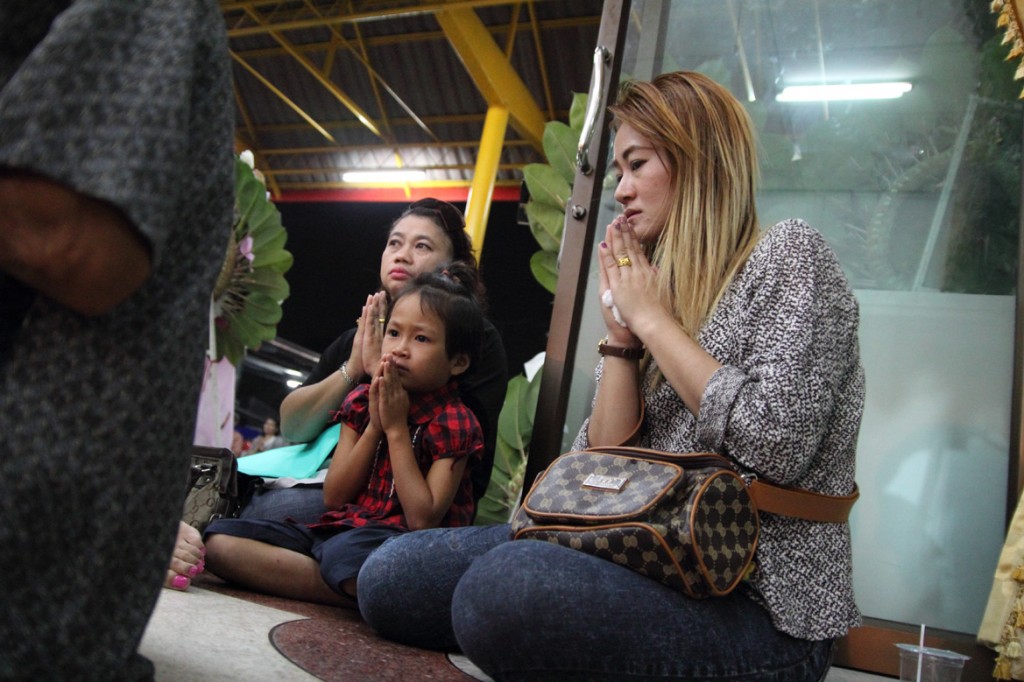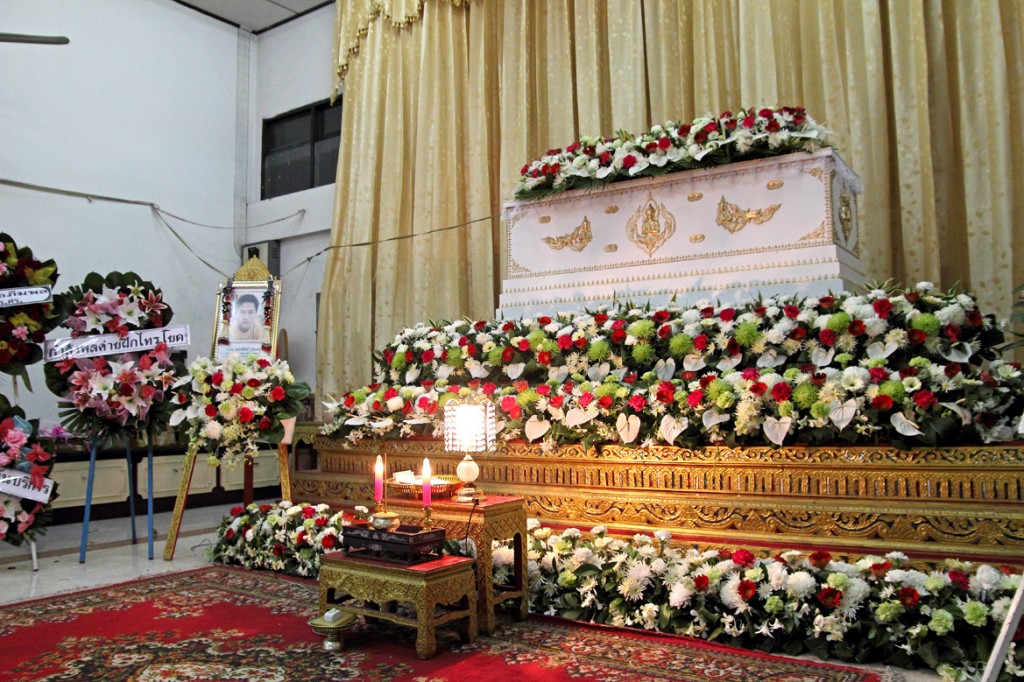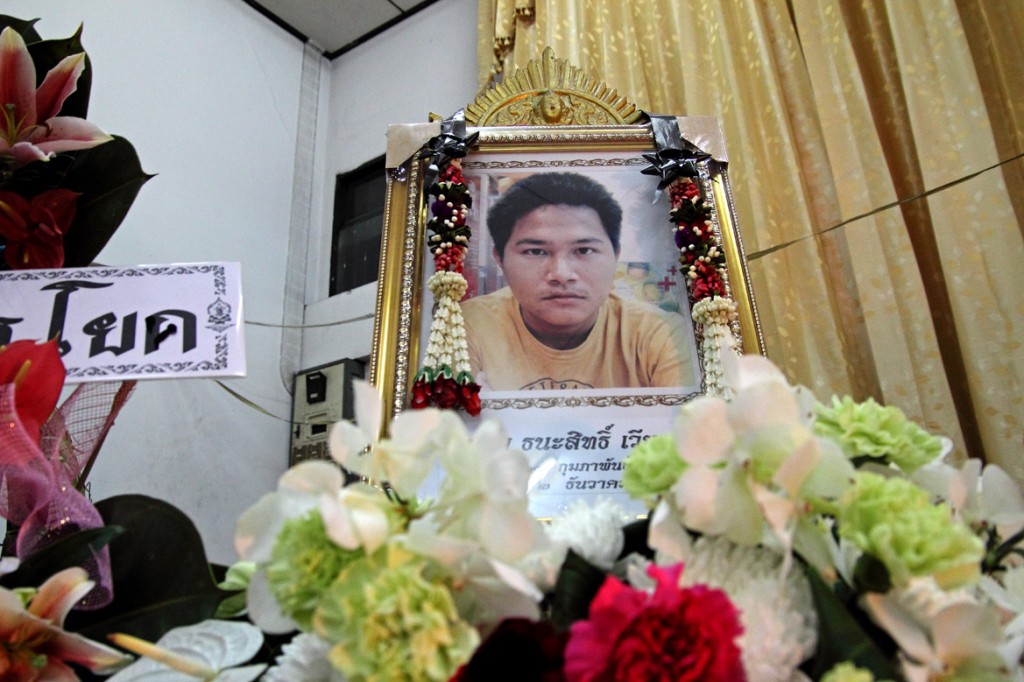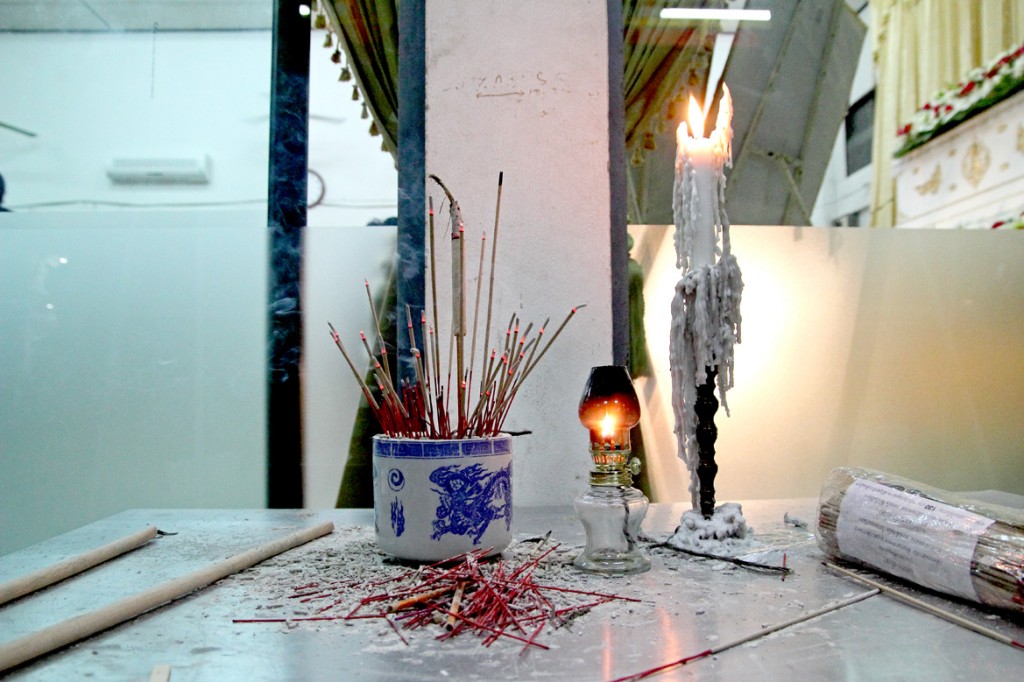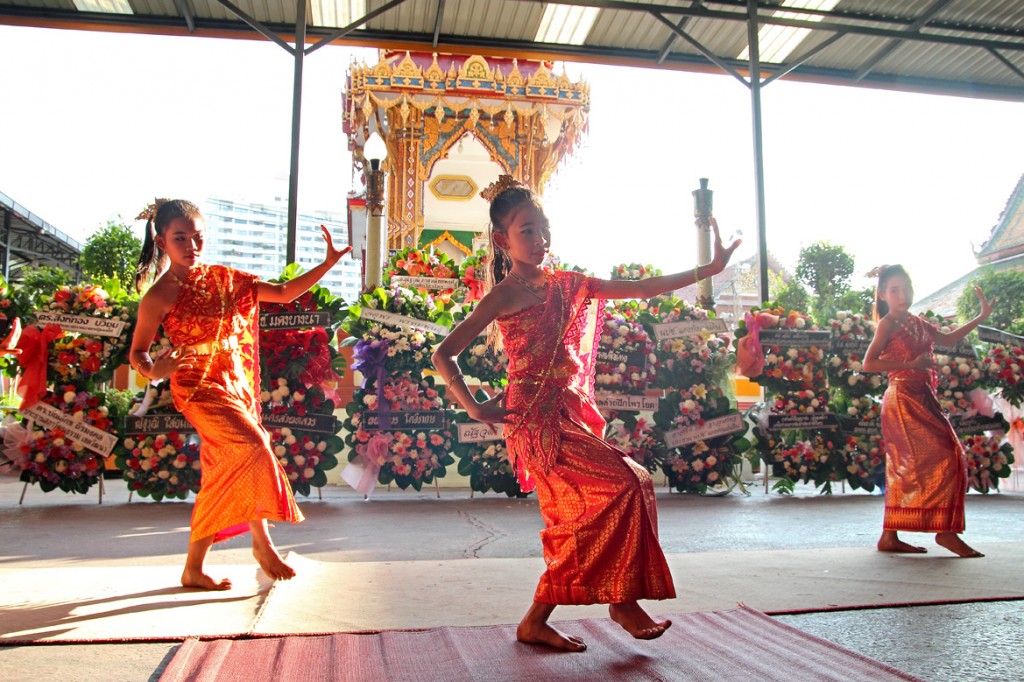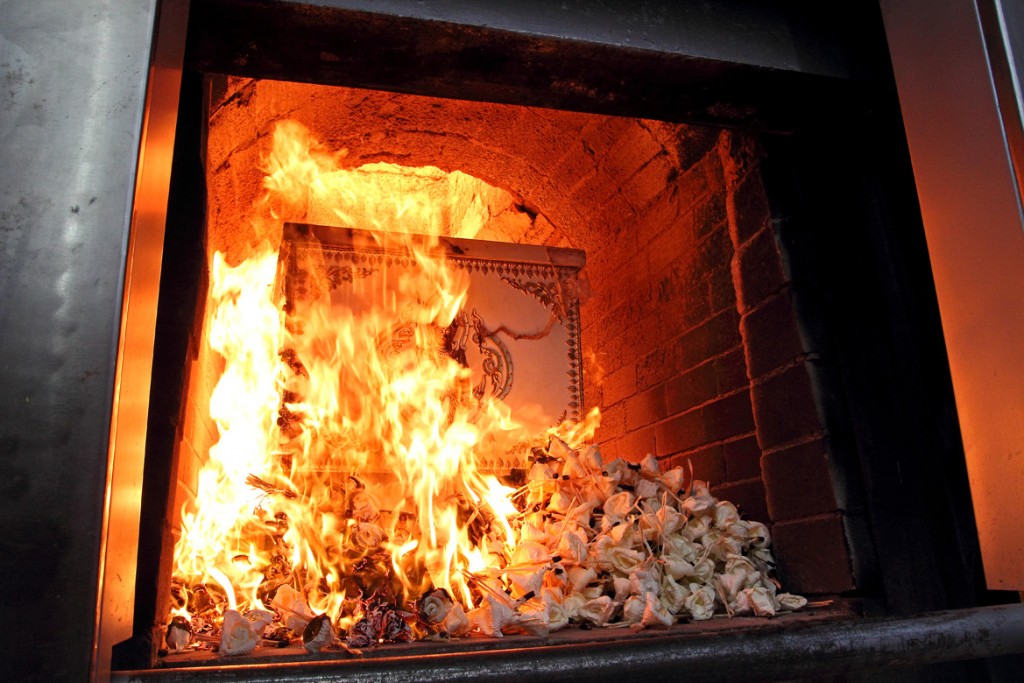*** WARNING: Graphic Content ***
This is my account of what I have seen at Rajamangala Stadium and at Ramkhamhaeng University on the night of Saturday, 30 November, and Sunday, 1 December 2013. Very few journalists were at the scene the entire night, as most of my colleagues were preparing for the expected clashes the following day at Government House and the Metropolitan Police Headquarters. I normally would most likely have done the same, if the attack against me on Monday, 25 November, and the following hate campaign had not have made it impossible for me to go again to the anti-government protests. I set off to the Red Shirt mass gathering at Rajamangala Stadium, mostly because it was a safe place for me, and because I needed to get out and do something instead of just being depressed at home. I wanted at least to take a photo of Rajamangala Stadium filled with red shirt protesters – always an impressive sight. I had not the slightest idea that I was going to witness and experience that night the most brutal clashes since 2010.
I have held back my account until now, partly out of fear that I could be even more of a target. The anti-government protest groups’ narrative was to a large part quite contrary to what I have seen, in many cases.I have also waited for more confirmation of facts and additional information.
On Saturday, 30 November, I set off from home at about 16.00 on my motorcycle. Usually the trip to Rajamangala would have taken me about 30 to 40 minutes, but that day it took me almost 1.5 hours. At first I did not know why the streets were so badly gridlocked, the traffic hardly moving at all, but when my wife called me not long before I reached Rajamangala it became clear. She said that the news reported that Ramkhamhaeng University students had blocked Ramkhamhaeng Road, searching vehicles for Red Shirts and beating them up. Fortunately, and s0mewhat flukishly, I decided that day to take Lad Phrao Road, and not as usual the Rama 9 Road route, which would have forced me to pass the University where the students were searching for Red Shirts. When I finally arrived I met a few of my colleagues who had just photographed the students beating up Red Shirts. One of them told me that one of the students briefly slapped a foreign photographer when he took images of the scene. I stayed away from the University and the anti-government student protesters because I could not take the risk of being recognized by them after the hate campaign against me by the Blue Sky Channel’s Facebook page. I would have likely gotten the same treatment the Red Shirts received. My colleagues said that it is not exactly clear who started the actual fighting, but that the students now pulled out every Red Shirt from buses, taxis and private cars they could get their hands on. Later, a friend who was at the university entrance at about 14.30 to 15.00 said to me that at that time the mood was already very aggressive under the control of the students and the guards wearing black shirts and headbands in Thai national colors, who at the time still remained at the entrance where a mobile stage was located, and who shouted at every passing car or motorcycle carrying Red Shirts.
In the medic’s tent in front of the arena, a Red Shirt protester who was beaten up was being nursed. He was stuck there as medical evacuation was too risky. Vichit Kalayatho, 45, said that the incident took place at about 16.00 and that he was the only Red Shirt protester on a public bus. When students surrounded the bus, and began beating in the windows, he decided to get off the bus not to endanger the other passengers. He was dragged into Ramkhamhaeng Soi 43, just opposite the University’s main entrance, and beaten by 10 to 20 people, forced to take off his red t-shirt, was relieved of his mobile phone, and sent off with a warning not to go to the stadium. He made his way to the stadium though, with possibly several fractured ribs in his upper chest area or a fractured collarbone, and many other bruises all over his body. Only at about 19.30 rescue volunteers from the outside managed to evacuate him, carrying him on a stretcher out of the stadium and further up the road towards Hua Mak Police Station where their ambulance was parked.
By sunset the students gathered on the opposite side of Ramkhamhaeng Road, screaming at and taunting the Red Shirts. Police, only armed with batons and shields, protected the entry of the stadium on the side of the road, while other officers redirected the traffic further up.
The Red Shirts at the gate armed themselves with sticks and iron bars, to protect themselves against a possible assault by the students. But they stayed defensive, and remained behind the thin and insufficiently armed police line inside the stadium, and at the lawn behind a small lake between the road and the lawn.
At the back gates to the stadium the situation was similar, the small alleys not safe for Red Shirts. Rajamangala Stadium was de-facto surrounded and besieged with the Red Shirts not being able approach or to go out of the stadium out of fear of being attacked and beaten up.
At about 20.00 I walked towards the stage entry, when a small bomb was thrown from the University over the fence into Rajamangala Stadium, shattering the windshield of a car parked inside the stadium area. I saw smoke wafting from the impact area.
I then went inside the stadium, where I took my images of the arena packed with Red Shirt protesters.
When finished I went to Gate 5, leading out to Ramkhamhaeng Soi 24, where Red Shirts armed with sticks assembled behind the thin police lines inside the stadium area. A police helicopter with searchlight circled all the time. It was an eerie scene, and reminded me somewhat of events in 2010.
At 21.40 the noise of gunfire came from the adjacent University area towards the backstage entry. Red Shirts crouched behind parked cars, and ran, ducking for cover. Guards tried to see where the shooter was located, on a University building or in the grounds at the wall. I remained there for about 30 minutes.
When things stayed quiet I moved towards Gate 5 again, where clashes were reported to take place in Ramkhamhaeng Soi 24 just behind the stadium and at the back entrance of the University. At the gate I saw terrified Red Shirts who were stranded on the outside being let in.
At about 22.40 I slowly and carefully moved out towards the nearby fighting zone, a few hundred meters right of the gate up the lane, but decided to stay well behind the lines as I wanted to avoid the possibility of being captured and recognized by the students, whose shadows I could make out in the distance behind the Red Shirt lines. A few locals watched the scene from the side of the road. There was a lot of noise from gunfire and explosions of ping pong bombs. Soon a Red Shirt fighter rushed along, with two sticks raised in his hands, and screamed, elated, over and over again: “So many gunshots, and none of us got killed! None of us got killed!”
By then the Red Shirt fighters seemed to have pushed the students back into the university, and into the sub-laneways, away from the stadium. Some Red Shirts were at the University wall, from which still occasional gunshots and explosions were heard. I don’t know which side fired, and thought it was best not to go too close. When people from buildings in upper floors looked out, Red Shirts shouted at them to close their windows. They explained to me that from some buildings people threw bottles at them during the fighting.
At about 23.30 a long line of police cars arrived, some remained further up the lane where some of the students were, and the remainder stopped at the Red Shirt held area. The Red Shirt fighters cheered the police. By then the situation was far less chaotic.
A few foreign colleagues of mine walked by. They were present during the main fighting. They said that the frontlines were constantly shifting, that one moment they were with the students, and the next with the Red Shirts, which confirmed to me that I made the right decision to stay back. One showed me images of the killed student, and of a badly injured and captured Red Shirt.
Red Shirts and police led terrified employees of a Pizza Company store out: the front window had been destroyed, a motorcycle thrown into the store. The Red Shirts said that from the upper floor of the building people threw bottles and possibly explosives at them during the fighting.
At midnight there was still some commotion at sub-soi 14, where a gang of students were still active deeper in the dark of the laneway. A Red Shirt lightly injured by a bottle thrown at him walked out, and straight after another Red Shirt who screamed that he was shot in the arm was driven out by motorcycle.
Things then remained calm, and I walked back towards the stadium, from where I still heard noise of occasional gunfire. I walked towards the main gate, where things were calm. On the way back, I saw that Red Shirt guards had captured a middle aged man with rge insignia of the anti-government protesters, and led him to the stage area, shouting at Red Shirt protesters not to attack him.
They managed to bring him unharmed behind the stage even though enraged Red Shirts tried to attack him. The young 17-year-old boy who was shot in the arm just previously pointed him out there as the man who shot him.
The middle aged man was brought to a room near the backstage entry for further interrogation, and was then handed to police. I was thirsty, and asked for water, but there was no drinking water left in the stadium.
I walked back to the alleys behind Gate 5. At Ramkhamhaeng Soi 24, sub-soi 14, I could see deep in the dark laneway student fighters taunting Red Shirts. A noodle soup vendor arrived with his cart out of the dark of the soi, and sold soup to the assembled Red Shirts. A group of Red Shirt fighters rushed into the soi to chase the students away. June, a young Thai documentary film maker, and I were the only journalists there. We decided to only go about 30 meters into the soi. Suddenly from deeper in the laneway we heard 6 gunshots. It was about 1.55, on 1 December 2013. Soon after a Red Shirt came running towards us, screaming that one of them was killed. A group of Red Shirts rushed towards us, carrying a body. I snapped a few images. A Ruamkatanyu rescue truck arrived, the Red Shirts quickly loaded the body onto the truck, and it drove straightaway out of the soi. I managed to get one clear image of the body. He was shot in the head.
*** WARNING: Graphic Content ***
Red Shirt protesters stood around the man’s motorcycle helmet. I took images. First of the outside, where the entry hole of the bullet was visible. Then of the inside. Small pieces of brain matter stuck to the lining. Witnesses said that he was shot from 10 meters distance out of the second floor of a building housing mostly southern Thai students.
I saw people quietly entering a 7/11 store. I went there. The windows were taped shut with newspapers from the inside. Through a gap in the locked door I asked if I could buy some water, and explained that I was a foreign journalist. The employees looked through a gap, and slightly opened the door to take my 100 baht bill, and soon handed me two bags of water bottles. I kept one, gave one to June, and the remainder to the Red Shirts. June and I sat down on two plastic chairs at the side of the Soi. I still did not yet feel anything, but soon a terrible sadness overcame me. I had photographed yet again another young man killed.
June took with his smart phone images of the pictures I have just taken from my camera screen, and sent the news out to Prachatai, that one more person had been killed on that terrible night. Suddenly a group of Red Shirts, screaming in anger, walked into the Soi. One of them, while walking, repeatedly fired in the air with a pistol. We remained on our chairs.
Occasionally local residents passed, and the Red Shirts told them to be careful not to go too deep into the sois as they might be mistaken for Red Shirts by the students and attacked. Things calmed down then, and June and I walked to the stadium. I took photos of Red Shirts stranded there, waiting to be able to go home. Particular touching for me was a family with a small child, sleeping at a quiet corner near the back stage entry.
I went briefly behind the stage, where I photographed Red Shirt leaders involved in an intense discussion.
June and I went then to the main entry. It was tense, yet relatively calm. Police guarded the gate and Red Shirts behind them, and at the lawn behind the lake. Ramkhamhaeng Road was still in the hands of the anti-government students. At the lake, Red Shirts and students taunted each other with the occasional cracker fired from slingshots at each other (none reached its aim as the distance was too great), and shouted insults.
We went then back through gate 5 where we met a small group of Thai journalists at a hotel at Soi 24, just behind the gate. At about 5 am the first Red Shirts began leaving. I decided to wait for sunrise, to be on the safe side. June went home at about 5.30. Just before sunrise, the Thai journalists and I walked to Gate 1. Red Shirts applauded police officers during shift change.
Suddenly the Red Shirts ran towards a side gate, and streamed into Ramkhamhaeng Road.
Things got crazy. Explosions everywhere. Gunshots fired, from both sides. “Luad kuen na” (blood rises into the face) – a Thai expression for running amok. The Red Shirts, locked in the whole night in the stadium, drinking water having run out at already 23.00, went wild, chasing the students off the street. Somebody threw bombs at the Red Shirts from the overpass. A large group of Red Shirts ran towards the main gate of Ramkhamhaeng University. Gunfire. Red Shirts shouted that one of them was killed by several shots in the chest.
I remained at the gate area of the stadium. Soon several injured were brought in, one young man who was shot through the hand. Another man with a head wound — from what I don’t know. Things calmed again. The Red Shirts moved back into the stadium. The whole episode of mayhem lasted only 25 minutes.
The rally was cancelled by the UDD leaders, the Red Shirts now began leaving the stadium through the back gates, as it was now safe for them. I left as well, utterly exhausted. At home, I managed about 3 hours sleep, still running on adrenaline, and the emotions of that night. More information of that night came then in, and of more explosions and gunfire heard in the area, of the students being evacuated from the university by the military, and of the bus being burned and a skeleton being found there. The death toll of that night was 1 killed anti-government student (Thaweesak Phokaew, 21), 3 killed Red Shirts (Thanasit Viengkham, 22, Viroj Khemnak, 43, and Visanu Phaophu, 26), and a teenager (Suradet Khampaengjai, 19) whose death was first a mystery, but which then days later was said in a Bangkok Post article that he with his friends burned a bus that transported Red Shirts and who could not leave the bus as the fire spread too quickly.
While still much of what took place that night is sketchy, enough facts have come to light by now to ask some very uncomfortable questions of what led to the violence in the first place. It is necessary to give a brief background here. The UDD chose Rajamangala Stadium as their protest venue for two main reasons.
First, because Rajamangala is a symbolic venue for their struggle. Back in 2008, when the Red Shirts transformed their initially still rather disorganized movement into a mass social movement, they began with large mass gatherings, the first being at Muang Thong Thani Thunderdome on 11 October 2008, and the next and much larger one, with about 80 000 people, on 1 November 2008. Second, because the UDD wanted to give a focal point to Red Shirts away from the ongoing anti-government protests, trying to avoid clashes between the two rival protest groups but still needing to show their existence as government supporters as well. Their first venue of the Red Shirt counter protest was behind Impact Arena in Mueang Thong Thani on 10 November 2013, which had drawn about 50,000 to 60,000 people. When the anti-government protests intensified, they could not go there again as the Constitution Court is located close by, and it was just days before the crucial decision on the constitution changes regarding the Senate. Therefore Rajamangala Stadium was chosen instead to hold their daily gatherings, starting from 19 November 2013, which initially drew relatively small numbers, of between 5,000 to at most 30,000.
From the beginning, there was violence against Red Shirts. Vocational college students and other hardcore anti-government protesters roomed the upper sois of Ramkhamhaeng and Lad Phrao Roads, looking for lone Red Shirts. The initial attacks took place on the first night on Ramkhamhaeng Soi 53. While walking home, one Red Shirt protester was injured. During the night of 26 November, one Red Shirt was stabbed in the stomach (the image published showed the handle of the knife still sticking out) and during the same night a group of three Red Shirts were forced to undress, kicked and beaten with the poles of Thai national flags their tormentors carried, the scene filmed with the camera of a mobile phone of a bystander.
The Red Shirts then announced a big gathering for 30 November. I am sure that I will again be denounced as “biased” and a “Red Shirt journalist”, but I do question the motives of the anti-government students and their organizers to hold a counter rally at the same day at the adjacent Ramkhamhaeng University. Another part of the narrative that this incident was about “Red shirts” against “students” does not make any sense either. On the side of the Red Shirts were many Ramkhamhaeng students and alumni as well, including some I have met and talked with during the fighting at Ramkhamhaeng Soi 24. On the side of the anti-government students were also vocational students, and possibly others that had very little to do with the University. Since years there have been splits under the traditionally politically very active Ramkhamhaeng University students along the political faultiness – many students from south Thailand are yellow/pro-Democrat Party, and many northern and northeastern students are affiliated with the Red Shirts. Ramkhamhaeng students served as guards during both the Democrat Party organized Blue Sky rally stages for months, as they still do during the current anti-government protests. The Student Network stage at Nang Loern is dominated by Ramkhamhaeng students. And on the other side, the Red Shirts have their own networks in Ramkhamhaeng University, student leaders have appeared on many UDD and free Red Shirt stages. As early as 2006 and 2007 the initial mobilizations of UDD at Sanam Luang had guards who were Ramkhamhaeng students. UDD leader Jatuporn Prompan is a Ramkhamhaeng alumni. The university is simply a reflection of general Thai society which is deeply split in the political color code, and to a large part, but by not exclusively, along regional lines.
Another urban myth is quite obviously the simplistic narrative that the Red Shirts encircled the university and trapped the students. From my vantage point from within the Red Shirt camp, it was initially the other way around. Until the Red Shirts pushed the students back into the University at the back entry just before midnight the Rajamangala Stadium was encircled (the small sois in the back, though, remained too dangerous for Red Shirts until just before sunrise). The main entry of the University is at Ramkhamhaeng Road, and this road was in the hands of the anti-government students — to stick with the possibly incorrect but now common term — until sunrise. There is also the question how many of the anti-government fighters in the University were actually students, and how many were outside elements. I am quite sure that there were many innocent students trapped in the University, terrified by the fighting, by the constant noise of gunshots and explosions throughout the night and in the morning, who were too scared to leave the campus, and who became innocent targets because of the leaders’ choice of using the University as a place of protest against the Red Shirts.
There is no doubt whatsoever that there were violent and armed elements among those anti-government protesters in the University. Not only was one student shot dead, but also 3 Red Shirts and many others injured by bullets. This leads to the ultimate question of responsibility of anti-government protest leaders and the University authorities who have allowed a provocative anti-government protest set up directly at a venue which the UDD has chosen to avoid a violent confrontation in the first place — long before the anti-government protest groups decided to go there as well. Why did they go there when they have already occupied Rajadamnern and vicinity, the government complex at Chaeng Wattana, and the Finance Ministry?
While the Red Shirt leadership may be blamed for not having cancelled their gathering at Rajamangala earlier, when the first violent incidents occurred in the days leading up to the mass gathering on 30 November, this also leads to ask whether the Red Shirts are not allowed to hold any gatherings in Bangkok at all? I have recently visited a small free Red Shirt stage in Bangkok’s north. The organizers told me of shots fired at them late night by people passing by on motorcycles. Most Red Shirts there did not dress in their colors, for fear of being attacked on their way home.
Another obvious target to lay responsibility on was the police. But what could police have done? Go in with blazing guns (which the officers at the stadium did not have), facing two warring groups who themselves were armed? Then police would have been accused on the anti-government stages of having used disproportionate violence. Or, go in there with the shields and batons they were assigned with, and be shot like sitting ducks? Given that the police have been targeted by anti-government protesters, and accused of being “Khikha Thaksin” (Thaksin’s lackeys), any sort of police interference would most likely have escalated the already bad situation. But police did come to Ramkhamhaeng Soi 24, when there was a lull in the fighting, trying to keep the two sides apart. We can also not forget that there is a conflict between police and military units, and police fear that any impression that they use disproportionate violence against anti-government protesters could result in the military siding with the anti-government protesters. This scenario is not without precedent, as that’s exactly that happened in 2006 and 2008, when the military sided with the Yellow Shirts. From my perspective on the ground and given the above described scenario, I cannot think of what the police could have achieved by involving themselves any further than they did.
On 3 December 2013, and the following day, the cremation day, I went to the funeral of the young Red Shirt fighter who was killed that night and whose image I took. By now I knew his name — Thanasit Viangkham — a 22 year old conscripted soldier on leave. He left behind his wife, and a 5-year-old daughter. His whole family are active Red Shirts, both his wife and parents were that night in the Rajamangala Stadium as well. They said that Thanasit was fearless, and always at the forefront. Thanasit and his family also took part in the 2010 protests.
The funeral was like so many other Red Shirt funerals I have been to. Several hundred Red Shirts gathered, UDD leaders came, including Tida Thawornset and her husband Dr. Weng Tojirakan, even Pheua Thai MP Surachat Chanpadit had flown in from Sisaket province, the home province of Thanasit and his family. The UDD and the Pheua Thai party handed compensation money to the family. There were speeches, and a dance group performing a traditional funeral dance. Monks were handed robes, and soldiers from Thanasit’s unit attended as well. The Red Shirts were sad, and angry. When passing the coffin, some knocked on it and said: “Su Su” (Fight on). After the cremation the Red Shirts moved a few streets further, where the funeral of another Red Shirt killed that night was held.
Thanasit’s wife, Nikon Surawudh, said that she needs to go to the place where Thanasit died, to hold a religious ritual there: “The spirit of my husband is still there, he still fights, throws stones and bottles. He doesn’t know yet that he died. I have to help him to get away from there. I have to pray, light candles, burn joss sticks.”
But it was still too dangerous for her to go there.
 Facebook
Facebook  Twitter
Twitter  Soundcloud
Soundcloud  Youtube
Youtube  Rss
Rss 